Tamilnadu State Board New Syllabus Samacheer Kalvi 12th Physics Guide Pdf Chapter 6 Optics Text Book Back Questions and Answers, Notes.
Tamilnadu Samacheer Kalvi 12th Physics Solutions
Chapter 6 Optics
12th Physics Guide Optics Text Book Back Questions and Answers
Part – I:
Textbook Evaluation:
I. Multiple Choice Questions:
Question 1.
The speed of light in an isotropic medium depends on,
a) its intensity
b) its wavelength
c) the nature of propagation
d) the motion of the source w.r.t medium
Answer:
b) its wavelength
Question 2.
A rod of length 10 cm lies along the principal axis of a concave mirror of focal length 10 cm in such a way that its end closer to the pole is 20 cm away from the mirror. The length of the image is,
a) 2.5 cm
b) 5 cm
c) 10 cm
d) 15 cm
Answer:
b) 5 cm
Solution:
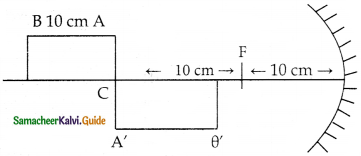
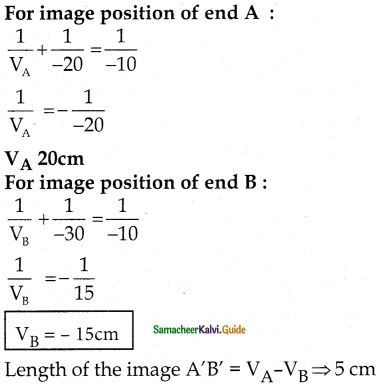
Question 3.
An object is placed in front of a convex mirror of focal length of f and the maximum and minimum distance of an object from the mirror such that the image formed is real and magnified.
a) 2f and c
b) c and ∞
c) f and O
d) None of these
Answer:
d) None of these
Question 4.
For light incident from the air onto a slab of refractive index 2. The maximum possible angle of refraction is,
(a) 30°
(b) 45°
(c) 60°
(d) 90°
Answer:
(a) 30°
Hint:
From Snell’s law, µ = \(\frac { sin i }{ sin r }\)
Now consider an angle of incident is 90°
\(\frac { sin 90° }{ 2 }\)
sin r = sin-1 (0.5)
r = 30°
Question 5.
If the velocity and wavelength of light in air is Va and λa, and that in water is Vw. and λw, then the refractive index of water is,
a) \(\frac{V_{\mathrm{W}}}{V_{\mathrm{a}}}\)
b) \(\frac{V_{\mathrm{a}}}{V_{\mathrm{w}}}\)
c) \(\frac{\lambda_{\mathrm{W}}}{\lambda_{\mathrm{a}}}\)
d) \(\frac{V_{\mathrm{a}} \lambda_{\mathrm{a}}}{V_{\mathrm{w}} \lambda_{\mathrm{W}}}\)
Answer:
b) \(\frac{V_{\mathrm{a}}}{V_{\mathrm{w}}}\)
Solution:
µ = \(\frac{V_{\mathrm{a}}}{V_{\mathrm{w}}}\)
![]()
Question 6.
Stars twinkle due to,
a) reflection
b) total internal reflection
c) refraction
d) polarisation
Answer:
c) refraction
Question 7.
When a biconvex lens of glass having a refractive index 1.47 is dipped in a liquid, it acts as a plane sheet of glass. This implies that the liquid must have a refractive index,
a) less than one
b) less than that of glass
c) greater than that of glass
d) equal to that of glass
Answer:
d) equal to that of glass
Solution:
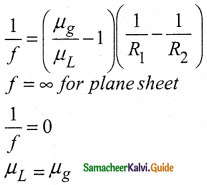
Question 8.
The radius of curvature of curved surface at a thin planoconvex lens is 10 cm and the refractive index is 1.5. If the plane surface is silvered, then the focal length will be
a) 5 cm
b) 10 cm
c) 15 cm
d) 20 cm
Answer:
b) 10 cm
Solution:
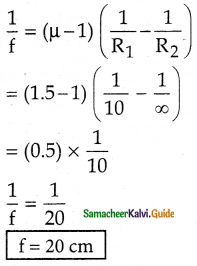
Question 9.
An air bubble in a glass slab of refractive index 1.5 (near-normal incidence) is 5 cm deep when viewed from one surface and 3 cm deep when viewed from the opposite face. The thickness of the slab is,
(a) 8 cm
(b) 10 cm
(c) 12 cm
(d) 16 cm
Answer:
(c) 12 cm
Hint:
Let d1 = 5 cm and d2 = 3 cm ; n = 1.5
Actual width is the sum of real depth from 2 sides
Thickness of slab = d1n + d2 n
= (5 x 1.5) +(3 x 1.5)= 12 cm
Question 10.
A ray of light travelling in a transparent medium of refractive index n falls, on a surface separating the medium from air at an angle of incidents of 45°. The ray can undergo total internal reflection for the following n,
a) n = 1.25
b) n = 1.33
c) n = 1.4
d) n = 1.5
Answer:
d) n = 1.5
Solution:
For total internal reflection i > ic
sin i > sin ic
sin45° > \(\frac{1}{\mu}\)
µ > √2
µ > 1.414
µ = 1.50
![]()
Question 11.
A plane glass is placed over a various coloured letters (violet, green, yellow, red) The letter which appears to be raised more is,
a) red
b) yellow
c) green
d) violet
Answer:
d) violet
Question 12.
Two-point white dots are 1 mm apart on a black paper. They are viewed by eye of pupil diameter 3 mm approximately. The maximum distance at which these dots can be resolved by the eye is, [take wavelength of light, λ = 500 nm]
a) 1 m
b) 5 m
c) 3 m
d) 6m
Solution:
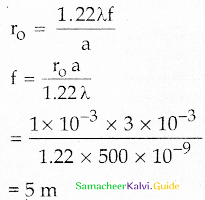
Question 13.
In Young’s double-slit experiment, the slit separation is doubled. To maintain the same fringe spacing on the screen, the screen-to-slit distance D must be changed to,
(a) 2D
(b) \(\frac { D }{ 2 }\)
(c) √2D
(d) \(\frac { D }{ √2 }\)
Answer:
(a) 2D
Hint:
Young’s double -slite experiment is
β = \(\frac { λD }{ d}\) ; β’ = \(\frac { λD’ }{ d’}\) ; d’ = 2d
Same fringe space, β = β’
⇒ \(\frac { λD }{ d}\) = \(\frac { λD’ }{ d’}\) ; D’ = 2D
Question 14.
Two coherent monochromatic light beams of intensities I and 4I are superposed. The maximum and minimum possible intensities in the resulting beam are
a) 5I and I
b) 5I and 3I
c) 9I and I
d) 9I and 3I
Answer:
c) 9I and I
Solution:
Imax = I + 4I + 2\(\sqrt{I \times 4 I}\)
= 5I + 4I = 9I
Imin = I × 4I – 2\(\sqrt{I \times 4 I}\)
= 5I – 4I = I
Question 15.
When light is incident on a soap film of thickness 5 × 10-5 cm, the wavelength of light reflected maximum in the visible region is 5320 Å. Refractive index of the film will be,
a) 1.22
b) 1.33
c) 1.51
d) 1.83.
Answer:
b) 1.33
Solution:
2µt cos r = (2n + 1)\(\frac{\lambda}{2}\)
For normal incidence
cos r = 1
for n = 0,
λ1 = 4µt = 26600 Å
n = 1,
λ2 = \(\frac{4 \mu t}{3}\) = 8866 Å
n=2,
λ3 = \(\frac{4 \mu t}{5}\) = 5320 Å
2µt = \(\frac{5 \lambda}{2}\)
µ = \(\frac{5 \lambda}{4 t}\)

α = 1.33
![]()
Question 16.
First diffraction minimum due to a single slit of width 1.0 × 10-5 cm is at 30°. Then wavelength of light used is,
a) 400 Å
b) 500 Å
c) 600 Å
d) 700 Å
Answer:
b) 500 Å
Solution:
d sin θ = n λ
d sin 30° = λ
1 × 10-7 × \(\frac{1}{2}\) = λ
0.5 × 10-7 = λ
λ = 500 Å
Question 17.
A ray of light strikes a glass plate at an angle 60°. If the reflected and refracted rays are perpendicular to each other, the refractive index of the glass is,
(a) √3
(b) \(\frac { 3 }{ 2 }\)
(c) \(\sqrt { \frac { 3 }{ 2 } } \)
(d) 2
Answer:
(a) √3
Hint.
Angle of refraction r = 60° ; Angle of incident i = 30°
sin i =n x sin r
n = \(\frac {sin 30°}{ sin 60°} \) = √3
Question 18.
One of the of Young’s double slits is covered with a glass plate as shown in figure. The position of central maximum will, Glass slide Screen will,
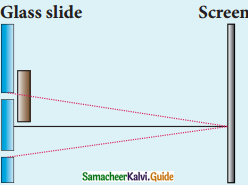
a) get shifted downwards
b) get shifted upwards
c) will remain the same
d) data insufficient to conclude
Answer:
b) get shifted upwards
Question 19.
Light transmitted by Nicol prism is,
a) partially polarised
b) unpolarised
c) plane polarised
d) elliptically polarised
Answer:
c) plane polarised
Question 20.
The transverse nature of light is shown in,
a) interference
b) diffraction
c) scattering
d) polarisation
Answer:
d) polarisation
![]()
II. Short Answer Questions:
Question 1.
State the laws of reflection.
Answer:
(a) The incident ray, reflected ray and normal to the reflecting surface all are coplanar (ie. lie in the same plane).
(b) The angle of incidence i is equal to the angle of reflection r. i = r
Question 2.
What is angle of deviation due to reflection?
Answer:
The angle between the incident and deviated light ray is called angle of deviation.
Question 3.
Give the characteristics of image formed by a plane mirror.
Answer:
- The image formed by a plane mirror is virtual, erect, and laterally inverted.
- The size of the image is equal to the size of the object.
- The image distance far behind the mirror is equal to the object distance in front of it.
- If an object is placed between two plane mirrors inclined at an angle 0, then the number of images n formed is as, n = \(\left( \frac { 360 }{ \theta } -1 \right) \)
Question 4.
Derive the relation between f and R for a spherical mirror.
Answer:
1. C be the center of curvature of the mirror
2. F be the principal focus.
3. Line CM is normal to the mirror at M.
4. i be the angle of incidence
∠MCP = i and ∠MFP = 2 i
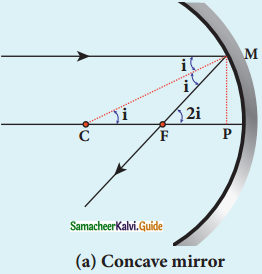
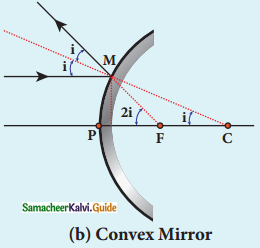
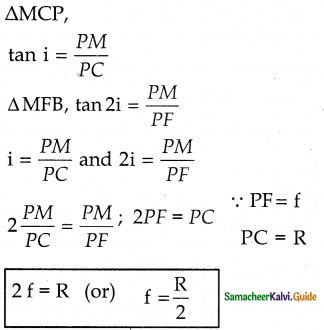
Question 5.
What are the Cartesian sign conventions for a spherical mirror?
Answer:
- The Incident light is taken from left to right (i.e. object on the left of the mirror).
- All the distances are measured from the pole of the mirror (pole is taken as origin).
- The distances measured to the right of pole along the principal axis are taken as positive.
- The distances measured to the left of pole along the principal axis are taken as negative.
- Heights measured in the upward perpendicular direction to the principal axis are taken as positive.
- Heights measured in the downward perpendicular direction to the principal axis, are taken as negative.
![]()
Question 6.
What is optical path? Obtain the equation for optical path of a medium of thickness d and refractive index n.
Answer:
1. Optical path of a medium is defined as the distance d’ light travels in vacuum at the same time it travels a distance ‘d’ in the medium.
2. n = refractive index.
3. d = thickness
ν = speed of light in the medium
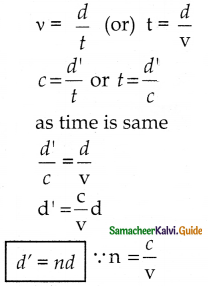
As ‘n’ is always greater than 1, the optical path d’ of the medium is always greater than 1.
Question 7.
State the laws of refraction.
Answer:
Law of refraction is called Snell’s law.
Snell’s law states that,
(a) The incident ray, refracted ray and normal to the refracting surface are all coplanar (i.e. lie in the same plane).
(b) The ratio of angle of the incident i in the first medium to the angle of reflection r in the second medium is equal to the ratio of the refractive index of the second medium n2 to that of the refractive index of the first medium n1.
\(\frac { sin i }{ sin r }\) = \(\frac { { n }_{ 2 } }{ { n }_{ 1 } } \).
Question 8.
What is angle of deviation due to refraction?
Answer:
- When light travels from rarer to denser it deviates towards normal.
d = i – r - When light travels from denser to rarer it deviates away from normal.
d = r – i
Question 9.
What is the principle of reversibility?
Answer:
The principle of reversibility states that light will follow exactly the same path if its direction of travel is reversed.
Question 10.
What is relative refractive index?
Answer:
\(\frac{\mathrm{n}_{2}}{\mathrm{n}_{1}}\) is called relative refractive index. It is the ratio of refractive index of the second medium with respect to the first medium.
Question 11.
Obtain the equation for apparent depth.
Answer:
Light from object O at the bottom passes from denser (water) to rarer medium (air).
n1 and n2 are refractive of denser and rarer medium.
By snells law
n1 sin i = n2 sin r
sin i ≈ tan i, as i and r are small
n1 tan i ≈ n2 tan i
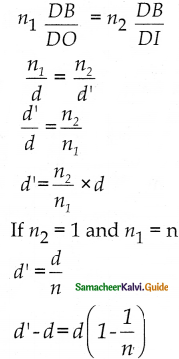
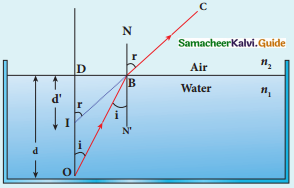
Apparent depth
![]()
Question 12.
Why do stars twinkle?
Answer:
- Light from the stars near the horizon reaches the earth obliquely through the atmosphere.
- It’s path changes due to refraction.
- Frequent atmosphere disturbances changes the path of light causes twinkling of stars.
Question 13.
What is critical angle and total internal reflection?
Answer:
The angle of incidence in the denser medium for which the refracted ray graces the boundary is called critical angle ic.
The entire light is reflected back into the denser medium itself. This phenomenon is called total internal reflection.
Question 14.
Obtain the equation for critical angle.
Answer:
The angle of incidence in the denser medium for which the refracted ray grace the boundary is called critical angle.
Snell’s law in Product form
n1 sin ic = n2 sin 90°
n1 sin ic = n2
sin ic = \(\frac{n_{2}}{n_{1}}\)
here n1 > n2,
If the rarer medium is air
n1 = n and n2 = 1
sin ic = \(\frac{1}{n}\)
ic = sin-1 \(\frac{1}{n}\)
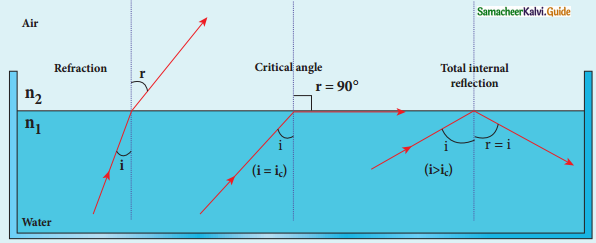
critical angle and total internal reflection
Question 15.
Explain the reason for glittering of diamond.
Answer:
The diamond appears dazzling because the total internal reflection of light happens inside the diamond. The refractive index of only diamond is about 2.417. It is much larger than that for ordinary glass which is about only 1.5. The critical angle of a diamond is about 24.4°. It is much less than that of glass. A skilled diamond cutter makes use of this larger range of angle of incidence (24.4° to 90° inside the diamond), to ensure that light entering the diamond is total internally reflected from the many cut faces before getting out. This gives a sparkling effect for diamonds.
Question 16.
What are mirage and looming?
Answer:
- It is an optical illusion observed in deserts or over hot extended surfaces like a coal – tarred road, due to which a traveller sees a shimmering Pond of water some distances ahead of him and in which the surrounding objects like trees etc appear inverted.
- In cold regions like glaciers and frozen lakes, the reverse effect of mirage will happen hence an inverted image is formed little above the surface. This phenomenon is called looming.
Question 17.
Write a short note on the prisms making use of total internal reflection.
Answer:
- Prisms can be designed to reflect light by 90° or 180°.
- It can also used to invert images without changing their size.
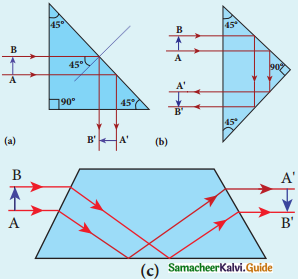
Prisms making use of total internal reflection
Question 18.
What is Snell’s window?
Answer:
When light entering the water from outside is seen from inside the water, the view is restricted to a particular angle equal to the critical angle ic. The restricted illuminated circular area is called Snell’s window.
![]()
Question 19.
Write a note on optical fibre.
Answer:
- Principle – Total internal reflection.
- Inner part of optical fibre – core, outer part – cladding or sleeving.
- ‘µ’ of core must be higher than cladding.
- Light travels inside by means of total internal reflection with no appreciable loss in intensity of light.
- Even while bending the wire, total internal reflection ensures every reflection.
Question 20.
Explain the working of an endoscope.
Answer:
An endoscope is an instrument used by doctors which has a bundle of optical fibres that are used to see inside a patient’s body. Endoscopes work on the phenomenon of total internal reflection. The optical fibres are inserted in to the body through mouth, nose or a special hole made in the body. Even operations could be carried out with the endoscope cable which has the necessary instruments attached at their ends.
Question 21.
What are primary focus and secondary focus of convex lens?
Answer:
- Primary focus: It is defined as a point where an object should be placed to give parallel emergent rays to the principal axis.
- Secondary focus: It is defined as a point where all the parallel rays travelling close to the principal axis converge to form an image on the principal axis.
Question 22.
What are the sign conventions followed for lenses?
Answer:
- Sign of focal length is not decided on the direction of measurement of the focal length from the pole of the lens as they have two focal lengths (i.e Primary & Secondary focus)
- Focal length of thin lenses is taken as positive for a converging lens and negative for a diverging lens.
Question 23.
Arrive at lens equation from lens maker’s formula.
Answer:
- If the refractive index of the lens is n2 and it is placed in air, then n2 = n and n1 = 1.
- \(\frac{1}{f}=(n-1)\left(\frac{1}{R_{1}}-\frac{1}{R_{2}}\right)\) This equation is called lens maker formula. This can be altered as
- \(\frac{1}{\mathrm{v}}-\frac{1}{u}=\frac{1}{f}\) This equation is known as lens equation.
![]()
Question 24.
Obtain the equation for lateral magnification for thin lens.
Answer:
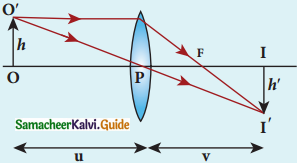
Lateral Magnificient in thin lens
1. OO’ be an object
2. II’ be the inverted real image.
3. Lateral Magnificient is defined as the ratio of height of the image to that of object.
4. m = \(\frac{I I^{\prime}}{O O^{\prime}}\)
∆ POO’ and ∆ PII’
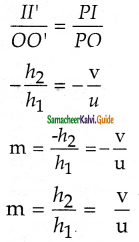
m is negative for real image, Positive for virtual image.
Concave lens, m is always positive and less than one.
m for combining lenses,
\(\mathrm{m}=\frac{h_{2}}{h_{1}}=\frac{f}{f+u}=\frac{f-\mathrm{v}}{f}\)
Question 25.
What is the power of a lens?
Power is reciprocal of focal length
P = \(\frac{1}{f}\)
Unit: diopter(D)
Question 26.
Derive the equation for effective focal length for lenses in contact.
Answer:
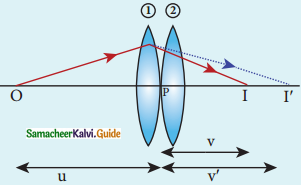
Lenses in Contact
1. Two lenses (1) and (2) having focal length are placed coaxially in contact.
2. Lens equation for first equation be
\(\frac{1}{v^{\prime}}-\frac{1}{u}=\frac{1}{f_{1}}\)
3. Lens equation for second lens be
\(\frac{1}{\mathrm{v}}-\frac{1}{\mathrm{v}^{\prime}}=\frac{1}{f_{2}}\)
4. Adding the above equation
\(\frac{1}{\mathrm{v}}-\frac{1}{u}=\frac{1}{f_{1}}+\frac{1}{f_{2}}\)
5. If the combinations acts as single lens then,
\(\frac{1}{\mathrm{v}}-\frac{1}{u}=\frac{1}{f}\)
6. On comparing,
\(\frac{1}{F}=\frac{1}{f_{1}}+\frac{1}{f_{2}}\)
∴ For any number of lens in contact
\(\frac{1}{f_{1}}+\frac{1}{f_{2}}+\frac{1}{f_{3}}+\)………..
Question 27.
What is the angle of minimum deviation?
Answer:
The minimum value of angle of deviation is called the angle of minimum deviation D.
![]()
Question 28.
What is dispersion?
Answer:
Dispersion is splitting of white light into its constituent colours. This band of colours is called spectrum.
Question 29.
How are rainbows formed?
Answer:
Rainbow is formed by dispersion of sunlight into its constituent colours by raindrops which disperse sunlight by refraction and deviate the colours by total internal reflection.
Question 30.
What is Rayleigh’s scattering?
Answer:
Scattering of light by a particle of size less than wavelength of light is called Rayleigh scattering which is inversely proportional to the fourth power of wavelength.
\(I \alpha \frac{1}{\lambda^{4}}\)
Question 31.
Why does sky appear blue?
Answer:
- Blue colour of sky is due to scattering of sunlight by molecules of the atmosphere (eg. N2, O2)
- ‘λ’b is smaller hence it scattered more strongly based on Rayleigh Scattering law.
- Hence sky appears blue.
Question 32.
What is the reason for reddish appearance of sky during sunset and sunrise?
Answer:
During sunrise or sunset, the sun is near the horizon. Sunlight has to travel a greater distance. So shorter waves of blue region are scattered away by the atmosphere. Red waves of longer wavelength are least scattered and reach the observer. So the sun appears red.
![]()
Question 33.
Why do clouds appear white?
Answer:
- A cloud is composed of large-sized partic1e which do not obey Rayleigh scattering law
- Therefore all colours are scattered nearly equal.
- Hence clouds appear white.
Question 34.
What are the salient features of the corpuscular theory of light?
Answer:
- According to this theory, light is emitted as tiny, massless (negligibly small mass) and perfectly elastic particles called corpuscles.
- As the corpuscles are very small, the source of light does not suffer appreciable loss of mass even if it emits light for a long time.
- On account of high speed, they are unaffected by the force of gravity and their path is a straight line in a medium of uniform refractive index.
- The energy of light is the kinetic energy of these corpuscles. When these corpuscles impinge on the retina of the eye, the vision is produced.
- The different size of the corpuscles is the reason for different colours of light.
- When the corpuscles approach a surface between two media, they are either attracted or repelled.
- The reflection of light is due to the repulsion of the corpuscles by the medium and refraction of light is due to the attraction of the corpuscles by the medium.
Question 35.
What is the wave theory of light?
Answer:
- Light travel as longitudinal waves in an invisible ether medium.
- This theory explains reflection, refraction, interference and diffraction.
- Existence of ether medium was disproved later.
- It could not explain the propagation of light in vacuum, polarisation phenomenon etc.
- It was proposed by Huygen.
Question 36.
What is electromagnetic wave theory of light?
Answer:
- It was proposed by maxwell.
- It is a transverse wave which does not require any medium.
- All phenomenon was successfully explained.
- It could not explain photoelectric effect and crompton effect.
Question 37.
Write a short note on the quantum theory of light.
Answer:
Light interacts with matter as photons to eject the electrons
A photon is a discrete packet of energy.
E = hυ
h = plancks constant
υ = frequency of radiation
Question 38.
What is a wavefront?
Answer:
A wavefront is the locus of points which are in the same state or phase of vibration.
Question 39.
What is Huygen’s principle?
Answer:
According to Huygens principle, each point of the wavefront is the source of secondary wavelets emanating from these points spreading out in all directions with the speed of the wave. These are called as secondary wavelets.
Question 40.
What is the interference of light?
Answer:
The phenomenon of addition or superposition of two light waves which produces increase intensity at some points and decrease in intensity at some other points is called interference of light.
![]()
Question 41.
What is a phase of a wave?
Answer:
Phase is the angular position of a vibration.
Question 42.
Obtain the relation between phase difference and path difference.
Answer:
Consider two waves of wavelength λ. A phase difference of 2π corresponds to a path difference of λ. If x is the path difference between two waves and φ is the phase difference then,
\(\delta=\frac{\lambda}{2 \pi} \phi\)
\(\delta\) – path difference, φ – Phase difference
Question 43.
What are coherent sources?
Answer:
Two light sources are said to be coherent if they produce waves which have same phase or constant phase difference, same frequency or wavelength (monochromatic), same waveform and preferably same amplitude.
Question 44.
What is intensity division?
Answer:
(i) Intensity or amplitude division:
1. If we allow light to pass through a partially silvered mirror (beam splitter), both reflection and refraction take place simultaneously.
2. As the two light beams are obtained from the same light source, the two divided light beams will be coherent beams.
3. They will be either in-phase or at constant phase difference.
4. Instruments like Michelson’s interferometer, Fabray- Perrot etalon work on this principle.
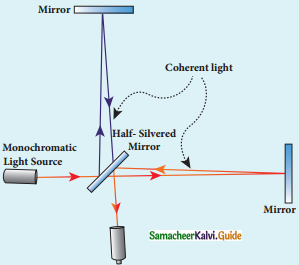
Question 45.
How does wavefront division provide coherent sources?
Answer:
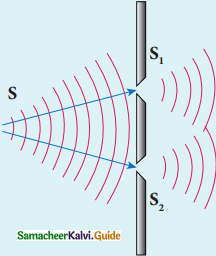
- A point source produces spherical wavefronts.
- All the points are in the same phase.
- If two points are chosen on the wavefront by using a double slit, It will act as coherent sources.
![]()
Question 46.
How do sources and images behave as coherent sources?
Answer:
Source and image will have waves in phase.
Fresnel biprism uses two virtual sources as two coherent sources.
Llyod’s mirror uses sources and its virtual image as two coherent sources.
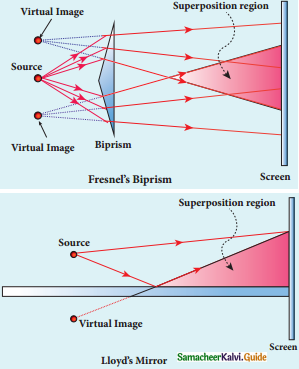
Question 47.
What is the bandwidth of the interference pattern?
Answer:
The bandwidth (β) is defined as the distance between any two consecutive bright or dark fringes.
Question 48.
What is diffraction?
Answer:
Bending of light around sharp edges is called diffraction.
Question 49.
Differentiate between Fresnel and Fraunhofer diffraction.
Answer:
| Fresnel diffraction | Fraunhofer diffraction |
| 1. Spherical or cylindrical wavefront undergoes diffraction | Plane wavefront undergoes diffraction |
| 2. Lightwave is from a source at finite distance | Lightwave is from a source at infinity |
| 3. For Laboratory conditions, convex lenses need not be used | In laboratory conditions, convex lenses are to be used |
| 4. Difficult to observe and analyse | Easy to observe and analyse |
5.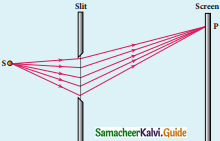 |
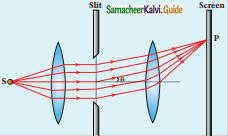 |
Question 50.
Discuss the special cases on the first minimum in Fraunhofer diffraction.
Answer:
1. Divide the slit AB into two halts AC and CB.
2. Two different points on the slit which are separated by the same width is corresponding points.
3. The path difference of light waves from corresponding points meet at p and interfere destructive to make first minimum.
δ = \(\begin{array}{l}
\text { a } \\
\hline 2
\end{array}\) sin θ
> The condition for p to first minimum
\(\frac{a}{2} \sin \theta=\frac{\lambda}{2}\)
a sin θ = λ (first minimum)
a sin θ = 2 λ (second minimum)
a sin θ = 3 λ (third minimum)
\(\frac{\mathrm{a} \sin \theta}{2 \mathrm{n}}=\frac{\lambda}{2}\) (nth minimum)
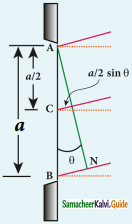
![]()
Question 51.
What is Fresnel’s distance? Obtain the equation for Fresnel’s distance.
Answer:
1. Fresnel’s distance is the distance up to which the ray optics is valid in terms of rectilinear propagation of light.
2. Fresnel’s distance is the distance up to which ray optics is obeyed and beyond which ray optics is not obeyed but, wave optics becomes significant.
3. From the diffraction equation for first minimum,
sin θ = \(\frac{\lambda}{a}\);
θ = \(\frac{\lambda}{a}\)
4. From the definition of Fresnel’s distance,
sin 2θ = \(\frac{a}{z}\) ;
2θ = \(\frac{a}{z}\)
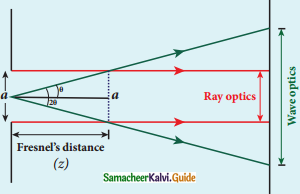
5. Equating the above two equation gives,
\(\frac{\lambda}{a}=\frac{a}{2 z}\)
6. After rearranging, we get Fresnel’s distance z as,
\(z=\frac{a^{2}}{2 \lambda}\)
Question 52.
Mention the differences between interference and diffraction.
Answer:
| Interference | Diffraction |
| 1. Superposition of two waves | Bending of waves around edges |
| 2. Superposition of waves from two coherent sources. | Superposition wavefronts emitted from various points of the same wavefront. |
| 3. Equally spaced fringes. | Unequally spaced fringes. |
| 4. Intensity of all the bright fringes is almost same. | Intensity falls rapidly for higher orders |
| 5. Large number of fringes are obtained | Less number of fringes are obtained. |
Question 53.
What is a diffraction grating?
Answer:
A diffraction grating is an optical component with a periodic structure that splits and diffracts light into several beams travelling in different directions.
Question 54.
What are resolution and resolving power?
Answer:
- Resolution is the quality of the image which is decided by diffraction effect and Rayleigh criterion.
- It is measured by the smallest distance which could be seen clearly without blur due to diffraction.
- The ability of an optical instrument to seperate or distinguish small or closely adjacent objects through the image formation is said to be resolving power.
Question 55.
What is Rayleigh’s criterion?
Answer:
The images of two-point objects are just resolved when the central maximum of the diffraction pattern of one falls over the first minimum of the diffraction pattern of the other.
![]()
Question 56.
What is polarisation?
Answer:
Polarisation is restricting electric or magnetic field vibrations to one plane.
Question 57.
Differentiate between polarised and unpolarised light.
Answer:
| Polarised light | Unpolarised light |
| 1. Consists of waves having their electric field vibrations in a single plane normal to the direction of the ray. | Consists of waves having their electric field vibrations equally distributed in all directions normal to the direction of the ray. |
| 2. Asymmetrical about the ray direction. | Symmetrical about the ray direction. |
| 3. It is obtained from unpolarised light with the help of polarisers. | Produced by conventional light sources. |
Question 58.
Discuss polarisation by selective absorption.
Answer:
- Selective absorption is the property of a material which transmits waves whose electric fields vibrate in a plane parallel to a certain direction of orientation and absorbs all other waves.
- The polaroids or polarisers are thin commercial sheets that make use of the property of selective absorption to produce an intense beam of plane polarised light.
- Selective absorption is also called dichroism.
Question 59.
What are polariser and analyser?
Answer:
Polariser: The Polaroid which plane polarises the unpolarised light passing through it is called a polariser.
Analyser: The polaroid which is used to examine whether a beam of light is polarised or not is called an analyser.
Question 60.
What are plane polarised, unpolarised and partially polarised light?
Answer:
- In-plane ploraised light the intensity varies from maximum to zero for every rotation of 90° of the analyser.
- If the intensity of light varies between maximum and minimum for every rotation of 90° of the analyser, the light is said to be partially polarised light.
- A Transverse wave which has vibrations in all directions in a plane perpendicular to the direction of propagation is said to be unpolarised light.
![]()
Question 61.
State and obtain Malus’ law.
Answer:
When a beam of plane polarised light of intensity I0 is incident on an analyser, the light transmitted of intensity I from the analyser varies directly as the square of the cosine of the angle θ between the transmission axis of polariser and analyser. This is known as Malus’ law.
I = I0 cos2θ
Proof:
1. Let us consider the plane of polariser and analyser are inclined to each other at an angle θ.
2. Let I0 be the intensity and ‘a’ be the amplitude of the electric vector transmitted by the polariser.
3. The amplitude ‘a’ of the incident light has two rectangular components, (acos θ) and (a sin θ) which are the parallel and perpendicular components to the axis of transmission of the analyser.
4. Only the component (a cosθ) will be transmitted by the analyser. The intensity of light transmitted from the analyser is proportional to the square of the component of the amplitude transmitted by the analyser.
5. I ∝ (a cos θ)2 I = k(a cos θ)2
Where k is constant of proportionality

Malu’s Law
I = ka2 cos2 θ
I = I0 cos2 θ
Where, I0 = ka2 is the maximum intensity of light transmitted form the analyser.
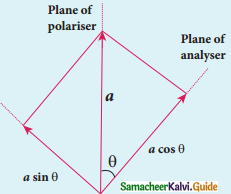
Special cases:
Case (i):
When θ = 0°, cos 0 = 1, I = I0
Case (ii):
When θ = 90°, cos 90° = 0, I = 0
Question 62.
List the uses of polaroids.
Answer:
- Polaroids are used in goggles and cameras to avoid glare of light.
- Polaroids are useful in three-dimensional motion pictures i.e., in holography.
- Polaroids are used to improve contrast in old oil paintings.
- Polaroids are used in optical stress analysis.
- Polaroids are used as window glasses to control the intensity of incoming light.
Question 63.
State Brewster’s law.
Answer:
Tangent of Polarising angle is numerically equal to the refractive index of the medium.
tan ip = µ
Question 64.
What is the angle of polarisation and obtain the equation for the angle of polarisation
Answer:
1. The angle of incidence at which the reflected beam is plane polarised light is called polarising angle (ip)
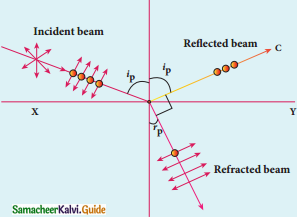
Polarisation by reflection
2. When ordinary light is incident on the surface of a transparent medium, the reflected light is partially plane polarised.
3. The extent of polarisation depends on the angle of incidence.
4. For a particular angle of incidence, the reflected light is found to be plane polarised.
5. The angle of incidence at which a beam of unpolarised light falling on a transparent surface is reflected as a beam of plane polarised light is called polarising angle or Brewster’s angle. It is denoted by i
6. At polarising angle, the reflected transmitted rays are perpendicular to other.
ip + 90° + rp = 180°
rp = 90° – ip
From Snell’s law,
\(\frac{\sin i_{p}}{\sin r_{p}}\) = n
7. Where n is the refractive index of the medium with respect to air.
8. Substitute the value of r from Equation, we get,
\(\frac{\sin i_{p}}{\sin \left(90^{\circ}-i_{p}\right)}\)}=\(\frac{\sin i_{p}}{\sin r_{p}}\) = n
tan ip = n
This relation is known as Brewster’s law.
Question 65.
Discuss pile of plates.
Answer:
1. The phenomenon of polarisation by reflection is used in the construction of pile of plates.
2. It consists of a number of glass plates placed one over the other in a tube
3. The plates are inclined at an angle of 33.7°(90° – 56.3°) to the axis of the tube. A beam of unpolarised light is allowed to fall on the pile of plates along the axis of the tube. So, the angle of incidence of light will be at 56.3° which is the polarising angle for glass.
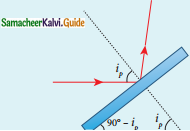
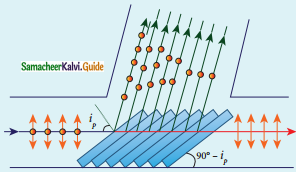
Pile of Plates
4. The vibrations perpendicular to the plane of incidence are reflected at each surface and those parallel to it are transmitted.
5. The larger the number of surfaces, the greater is the intensity of the reflected plane polarised light.
6. The pile of plates is used as a polarizer and also as an analyser.
![]()
Question 66.
What is double refraction?
Answer:
When a ray of unpolarised light is incident on a calcite crystal, two refracted rays are produced. Hence, two images of a single object are formed. This phenomenon is called double refraction.
Question 67.
Mention the types of optically active crystals with example.
Answer:
Uniaxial crystals :
Crystals with only one optic axis is called uniaxial crystals Ex: calcite, quartz, tourmaline.
Biaxial crystals:
Crystals with two optic axis is called biaxial crystal. Ex: Mica, topaz, selenite.
Question 68.
Discuss Nicol prism.
Answer:
Principle:
Double Refraction
Construction:
1. One of the most common forms of the Nicol prism is made by taking a calcite crystal which is a double refracting crystal with its length three times its breadth.
2. It is cut into two halves along the diagonal so that their face angles are 72° and 108°.
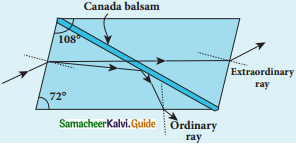
Nicol Prism
3. The two halves are joined together by a layer of Canada balsam, a transparent cement.
4. A ray of unpolarized light from monochromatic source such as a sodium vapour lamp is incident on the face AC of the Nicol prism. Double refraction takes place and the ray is split into ordinary and extraordinary rays.
5. They travel with different velocities.
6. The refractive index of the crystal for the ordinary ray (monochromatic sodium light) is 1.658 and for extraordinary ray is 1.486. The refractive index of Canada balsam is 1.523.
7. Canada balsam does not polarise light.
8. The ordinary ray is total internally reflected at the layer of Canada balsam and is prevented from emerging from the other face.
9. The extraordinary ray alone is transmitted through the crystal which is plane polarised.
Uses of Nicol prism:
- It produces plane polarised light and functions as a polariser
- It can also be used to analyse the plane polarised light (i.e) used as an analyser.
Drawbacks of Nicol prism:
- Its cost is very high due to the scarcity of large and flawless calcite crystals
- Due to extraordinary ray passing obliquely through it, the emergent ray is always displaced a little to one side.
- The effective field of view is quite limited
- Light emerging out of it is not uniformly plane polarised.
Question 69.
How is polarisation of light obtained by scattering of light?
Answer:
The light from a clear blue portion of the sky shows a rise and fall of intensity when viewed through a polaroid which is rotated. This is because of sunlight, which has changed its I direction (having been scattered) on encountering the molecules of the earth’s atmosphere. The electric field of light interact with the electrons present in the air molecules.
Under the influence of the electric field of the incident wave the electrons in the molecules acquire components of motion in both these directions. We have an observer looking at 90° to the direction of the sun. Clearly, charges accelerating parallel do not radiate energy towards this observer since their acceleration has no transverse component. The radiation scattered by the molecule is therefore polarized perpendicular to the plane.
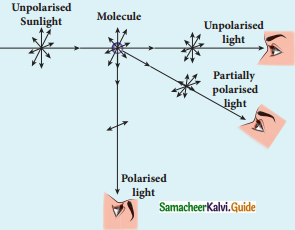
Polarisation by Scattering
Question 70.
Discuss simple microscope and obtain the equations for magnification for near point focusing and normal focusing.
Answer:
(i) A simple microscope is a single magnifying (converging) lens of small focal length.
(ii) The idea is to get an erect, magnified and virtual image of the object. For this the object is placed between F and P on one side of the lens and viewed from other side of the lens.
(1) Near point focusing:
The image is formed at near point, i.e. 25 cm for normal eye. This distance is also called as least distance D of distinct vision. In this position, the eye feels comfortable but there is little strain on the eye.
(2) Normal focusing:
The image is formed at infinity. In this position, the eye is most relaxed to view the image.
Magnification in near point focusing:
(i) Object distance u is less than f. The image distance is the near point D. The magnification m is given by the relation,
m = \(\frac{v}{u}\)
(ii) The magnification can further be written as,
m = 1 – \(\frac{v}{f}\)(using lens equation)
Substituting for ν with sign convention,
ν = -D
m = \(1+\frac{D}{f}\)
This is the magnification for near point focusing.
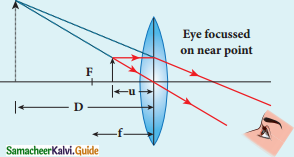
Magnification in normal focusing (angular magnification):
(i) The magnification for image is formed at infinity.
(ii) The angular magnification is defined as the ratio angle θi, subtended by the image with an aided eye to the angle θ0 subtended by the object with unaided eye.
m = \(\frac{\theta_{i}}{\theta_{0}}\)

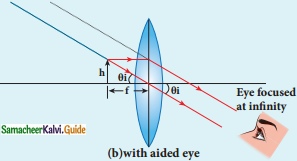
Normal focusing
For unaided eye
tan θ0 ≈ θ0 = \(\frac{h}{D}\)
For aided eye
tan θ0 ≈ θ0 = \(\frac{h}{f}\)
The angular magnification is,
m = \(\frac{\theta_{i}}{\theta_{0}}=\frac{h / f}{h / D}\)
m = \(\frac{D}{f}\)
This is the magnification for normal focusing.
![]()
Question 71.
What are the near point and normal focusing?
Answer:
Near Point focusing:
If the image is formed at 25 cm which is the distance of distinct vision for normal eye, then the focusing is called near point focusing.
Normal focusing:
If the image is formed at infinity then the focusing is called normal focusing.
Question 72.
Why is oil-immersed objective preferred in a microscope?
Answer:
By placing an immersion oil with a refractive index equal to that of the glass slide in the space filled with air, more light is directed through the objective and a clearer image is observed.
Question 73.
What are the advantages and disadvantages of using a reflecting telescope?
Answer:
Advantages:
- The main advantage is reflector telescope can escape from chromatic aberration because wavelength does not effect reflection.
- The primary mirror is very stable because it is located at the back of the telescope and can be support in the back.
- More cost-effective than refractor of similar size.
- Easier to make a high quality mirror than lens because mirror need to only concern with one side of the curvature.
Disadvantages:
- Optical misalignment can occur quite easily.
- Require frequent cleaning because the inside is expose to the atmosphere.
- Secondary mirror can cause diffraction of original incoming light rays causing the “Christmas star effect” where a bright object have spikes.
Question 74.
What is the use of an erecting lens in a terrestrial telescope?
Answer:
It makes the final image to be erect.
Question 75.
What is the use of collimator?
Answer:
The collimator is an arrangement to produce a parallel beam of light.
![]()
Question 76.
What are the uses of spectrometer?
Answer:
- To study the spectra of different sources of light.
- To measure the refractive index of materials.
Question 77.
What is myopia? What is its remedy?
Answer:
A human eye is shortsighted or myopic if it can see near objects clearly but is unable to see the far objects.
Remedy:
By using a concave lens of the required focal length.
Question 78.
What is hypermetropia? What is its remedy?
Answer:
A human eye can see distant objects clearly but cannot see near objects clearly is said to be suffering by long-sightedness or hypermetropia.
Remedy: By using concave of required focal length.
Question 79.
What is presbyopia?
Answer:
This defect is similar to hypermetropia i.e., a person having this defect cannot see nearby objects distinctly, but can see distant objects without any difficulty. This defect occurs in elderly persons (aged persons).
Question 80.
What is astigmatism?
Answer:
It is a defect of vision in which, a person cannot simultaneously see both horizontal and vertical lines with the same clarity.
![]()
III. Long Answer Questions:
Question 1.
Derive the mirror equation and the equation for lateral magnification.
Answer:
1. AB is an object considered on the principal axis of a concave mirror.
2. Consider three paraxial rays from point B on the object.
3. The three reflected rays intersect at the point ‘B’.
4. A perpendicular drawn as A’ B’ to the principal axis is the real, inverted image of the object AB.
5. ∆ BPA and ∆ B’PA are similar
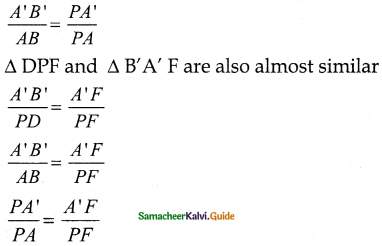
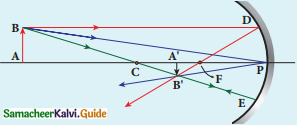
Mirror equation
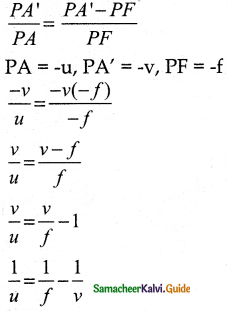
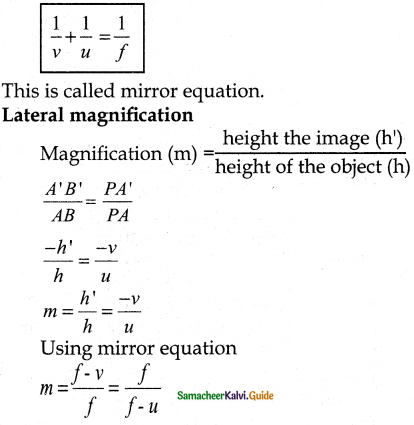
Question 2.
Describe Fizeau’s method to determine the speed of light.
Answer:
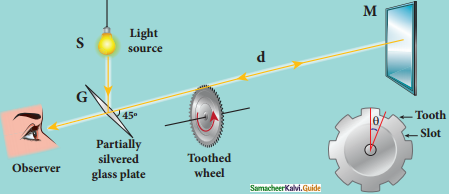
speed of light by Fizeau’s method
Apparatus:
- The light from a source S was first allowed to fall on a partially silvered glass plate G kept at an angle of 45°
- It is then allowed to fall on a rotating tooth wheel with N teeth and N cuts of equal widths.
- Light passing through one cut will be reflected by a mirror M kept at a long distance d (about 8 km)
- If the wheel is not rotating, it gets reflected by a partially silvered glass plate.
Working:
- Angular speed of rotation of wheel was increased from zero to GO Until it blocked by an adjacent tooth.
- It is ensured by the disappearance of light while looking partially silvered glass plate.
Expression:
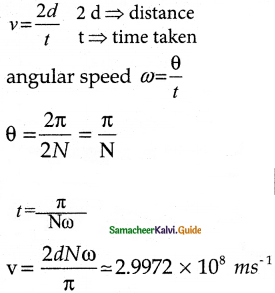
![]()
Question 3.
Obtain the equation for radius of illumination (or) Snell’s window.
Answer:
- When light entering the water from outside is seen from inside the water, the view is restricted to a particular angle equal to the critical angle ic.
- This restricted illuminated circular area is called Snell’s window.
- The angle of view for water animals is restricted to twice the critical angle 2ic. The critical angle for water is 48.6°. The angle of view is 97.2°.
- The radius R of the circular area depends on the depth d from which it is seen and the refractive indices of the media.
- Light is seen from a point A at a depth d.
Snell’s law
n1 sin ic = n2 sin 90°
n1 sin ic = n2 ∵ sin 90° = 1
sin ic = \(=\frac{n_{2}}{n_{1}}\)
6. From the Right angle triangle ∆ ABC,
sin ic = \(\frac{C B}{A B}=\frac{R}{\sqrt{d^{2}+R^{2}}}\)
Equating the above two equations
\(\frac{R}{\sqrt{d^{2}+R^{2}}}=\left(\frac{n_{2}}{n_{1}}\right)\)
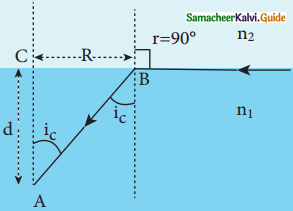
Radius of snell’s window
Squaring on both sides,
\(\frac{R^{2}}{R^{2}+d^{2}}=\left(\frac{n_{2}}{n_{1}}\right)^{2}\)
Taking reciprocal,
\(\frac{R^{2}+d^{2}}{R^{2}}=\left(\frac{n_{1}}{n_{2}}\right)^{2}\)
On further simplifying,
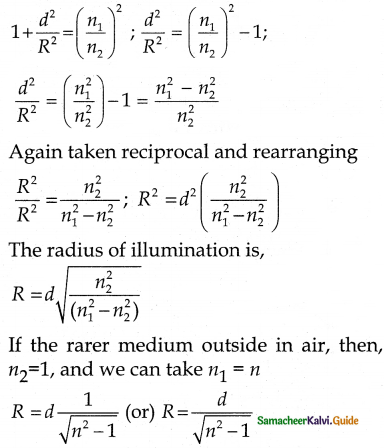
Question 4.
Derive the equation for acceptance angle and numerical aperture of optical fiber.
Answer:
1. To ensure the critical angle incident in the core-cladding boundary inside the optical fibre, the light should be incident at a certain angle at the end of the optical fiber while entering into it. This angle is called an acceptance angle.
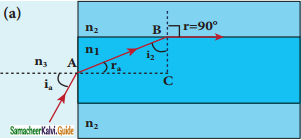
Acceptance angle
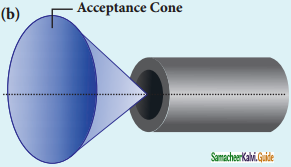
Acceptance Cone
2. By Snell’s law
n3 sin ia = n1 sin ra
To have the internal reflection inside optical fibre,
n1 sin i1 = n2 sin 90°
n1 sin ic = n2 sin 90° = 1
∴ sin ic = \(\frac{n_{2}}{n_{1}}\)
3. From the right angle triangle AABC,
ic = 90° – ra
Now, equation becomes
sin (90° – ra) = \(\frac{n_{2}}{n_{1}}\)
4. Using trigonometry,
cos ra = \(\frac{n_{2}}{n_{1}}\)
sin ra = \(\sqrt{1-\cos ^{2} r_{a}}\)
Substituting for cos ra
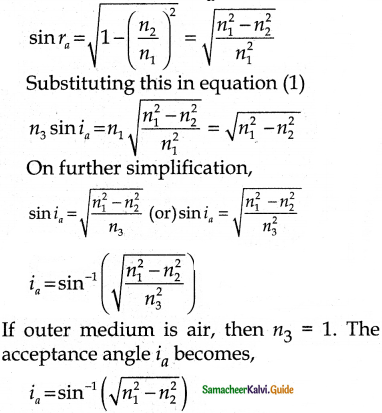
5. Light can have any angle of incidence from o to ia with the normal at the end of the optical fibre forming a conical shape called acceptance cone. The term (n3 sin ia) is called
numerical aperture NA of the optical fibre
NA = n3 sin ia = \(\sqrt{n_{1}^{2}-n_{2}^{2}}\)
6. If outer medium is air, then n3 = 1. The numeric aperture NA becomes,
NA = sin ia = \(\sqrt{n_{1}^{2}-n_{2}^{2}}\)
![]()
Question 5.
Obtain the equation for lateral displacement of light passing through a glass slab.
Answer:
1. When a ray of light passes through a glass slab it refracts at two refracting surfaces.
2. When the light ray enters the slab it travels from rarer medium (air) to denser medium (glass), results in deviation of ray towards the normal. When the light ray leaves the slab it travels from denser medium to rarer medium resulting in deviation of ray away from the normal.
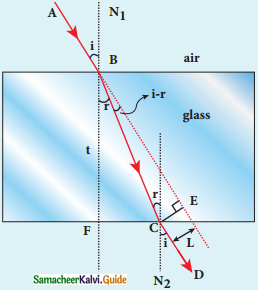
Refraction in glass slab
3. After the two refractions, the emerging ray has the same direction as that of the incident ray on the slab with a lateral displacement or shift L.
4. Consider a glass slab of thickness and refractive index n is kept in air medium.
5. In the right angle triangle ∆ BCE,
sin (i – r) = \(\frac{L}{B C}\);
BC = \(\frac{L}{\sin (i-r)}\) ……………(1)
6. In the right angle triangle ∆ BCF, ……………….(2)
cos(r) = \(\frac{t}{B C}\);
BC = \(\frac{t}{\cos (r)}\)
Equating equations (1) & (2)
\(\frac{L}{\sin (i-r)}=\frac{t}{\cos (r)}\)
7. After rearranging,
L = \(t\left[\frac{\sin (i-r)}{\cos (r)}\right]\)
Question 6.
Derive the equation for refraction at a single spherical surface
Answer:
1. Let us consider two transparent media having refractive indices n1 and n2 are separated by a spherical surface.
2. Let C be the centre of curvature of the spherical surface. Let a point object O be in the medium n1.
3. The line OC cuts the spherical surface at the pole P of the surface.
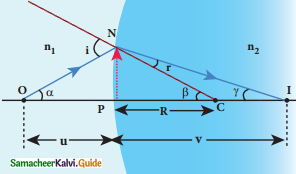
Refraction at single Spherical Surface
4. As the rays considered are paraxial rays, the perpendicular dropped for the point of incidence to the principal axis is very close to the pole or passes through the pole itself.
5. Light from O falls on the refracting surface at N. The normal drawn at the point of incidence passes through the centre of curvature C.
6. As n2 > n1, light in the denser medium deviates towards the normal and meets the principal axis at I where the image is formed,
7. By Snell’s law,
n1 sin i = n2 sin r
As the angles are small,
n1 i = n2 r
Let the angles,
∠ NOP = α, ∠ NCP = β ∠ NIP = γ
tan α = \(\frac{P N}{P O}\);
tan β = \(\frac{P N}{P C}\);
tan γ = \(\frac{P N}{P I}\)
8. As these angles are small, tan of angle could be approximated to the angle itself.
α = \(\frac{P N}{P O}\);
β = \(\frac{P N}{P C}\);
γ = \(\frac{P N}{P I}\)
for the triangle, ΔONC,
i = α + β
for the triangle, ΔINC,
β = r + γ (or) r = β – γ
9. on sub i & r, we get
n1 ( α + β) = n2 (β – γ)
Rearranging
n1α + n2γ = (n2 – n1)β
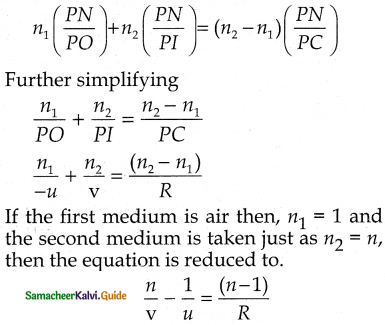
![]()
Question 7.
Obtain the lens maker’s formula and mention its significance.
Answer:
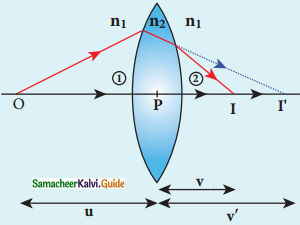
1. Let us consider a thin lens made up of a medium of refractive index n2 is placed in a medium of refractive index n1. Let R1 and R2 be the radii of curvature of two spherical surfaces (1) and (2) respectively.
2. The general equation for the refraction at a spherical surface is given from Equation
\(\frac{n_{2}}{v}-\frac{n_{1}}{u}=\frac{\left(n_{2}-n_{1}\right)}{R_{1}}\)
For the refracting surface (1) , the light goes from n1 to n2
3. \(\frac{n_{2}}{v}-\frac{n_{1}}{u}=\frac{\left(n_{2}-n_{1}\right)}{R_{1}}\)
For the refracting surface (2), the light goes from medium n2 to n1.
4. By adding
\(\frac{n_{1}}{\mathrm{v}}-\frac{n_{1}}{u}=\left(n_{2}-n_{1}\right)\left(\frac{1}{R_{1}}-\frac{1}{R_{2}}\right)\)
Further simplifying and rearranging,
\(\frac{1}{\mathrm{v}}-\frac{1}{u}=\left(\frac{n_{2}-n_{1}}{n_{1}}\right)\left(\frac{1}{R_{1}}-\frac{1}{R_{2}}\right)\) \(\frac{1}{\mathrm{v}}-\frac{1}{u}=\left[\frac{n_{2}}{n_{1}}-1\right]\left(\frac{1}{R_{1}}-\frac{1}{R_{2}}\right)\)5. If the object is at infinity, the image is formed at the focus of the lens.
Thus, for u = ∞, υ = f.
Then the equation becomes,
\(\frac{1}{\mathrm{v}}-\frac{1}{u}=\left[\frac{n_{2}}{n_{1}}-1\right]\left(\frac{1}{R_{1}}-\frac{1}{R_{2}}\right)\)
6. If the refractive index of the lensis n2 and it is placed in air, then n2 = n and n1 = 1. So the equation becomes,
\(\frac{1}{f}=(n-1)\left(\frac{1}{R_{1}}-\frac{1}{R_{2}}\right)\)
The above equation is called the lens maker’s formula,
7. \(\frac{1}{\mathrm{v}}-\frac{1}{u}=\frac{1}{f}\)
This is called lens equation.
Question 8.
Derive the equation for a thin lens and obtain its magnification.
Answer:
1. Let us consider an object OO’ of height h1 placed on the principal axis with its height perpendicular to the principal axis.
2. The ray OP passing through the pole of the lens goes undefeated.
3. The inverted real image II’ formed has a height h2
4. The lateral or transverse magnification m is defined as the ratio of the height of the image to that of the object.
m = \(\frac{I I^{\prime}}{O O^{\prime}}\)
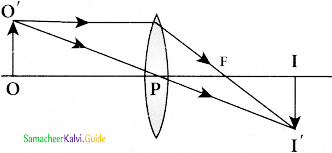
5. From the two similar triangle ∆POO’ and PII’, we can write,
\(\frac{I I^{\prime}}{O O^{\prime}}=\frac{P I}{P O}\)
Applying sign convention,
\(\frac{-h_{2}}{h_{1}}=\frac{\mathrm{v}}{-\mathrm{u}}\)
6. Substituting this in equation for magnification,
m = \(\frac{-h_{2}}{h_{1}}=\frac{\mathrm{v}}{-u}\)
After rearranging
m = \(\frac{h_{2}}{h_{1}}=\frac{\mathrm{v}}{\mathrm{u}}\)
7. The magnification is negative for real image and positive for the virtual image.
8. Magnification by combining the lens equation with the formula for magnification as,
\(m=\frac{h_{2}}{h_{1}}=\frac{f}{f+u}\) (or)
\(m=\frac{h_{2}}{h_{1}}=\frac{f-\mathrm{v}}{f}\)
Question 9.
Derive the equation for effective focal length for lenses in out of contact.
Answer:
Focal length of lens in out of contact:
1. Let O be a point object on the principal axis of a lens. OA is the incident ray on the lens at a point A at a height h above the optical centre. The ray is deviated through an angle δ and forms the image I on the principle axis.
2. The incident and refracted rays subtend the angles. ∠ AOP = α and ∠ AIP = β with the principle axis respectively.
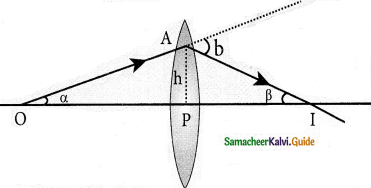
3. In the triangle ∆ OAI, the angle of deviation δ can be δ = α + β
If the height h is small as compared to PO and PI the angles α, β and δ are also small then,
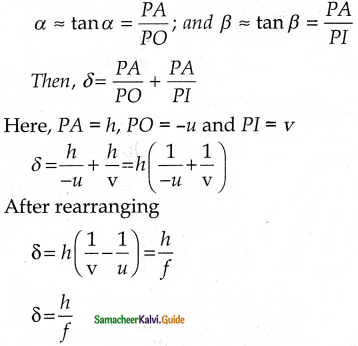
4. For a parallel ray that falls on the arrangement, the two lenses produce deviations δ1 and δ2 respectively and The net deviation δ is
δ = δ1 + δ2
δ1 = \(\frac{h_{1}}{f_{1}}\)
δ2 = \(\frac{h_{2}}{f_{2}}\)
δ = \(\frac{h_{1}}{f}\) …………(1)
\(\frac{h_{1}}{f}=\frac{h_{1}}{f_{1}}+\frac{h_{2}}{f_{2}}\)
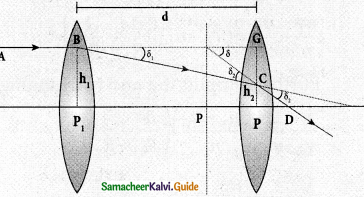
Lens in out of contact
From the geometry,
h2 – h1 = P2G – P1G = CG
h2 – h1 = BG tan δ1 ≈ BG δ1
h2 – h1 = \(\frac{d h_{1}}{f_{1}}\)
h2 = h1 + \(\frac{d h_{1}}{f_{1}}\) ……………..(2)
\(\frac{h_{1}}{f}=\frac{h_{1}}{f_{1}}+\frac{h_{1}}{f_{2}}+\frac{h_{1} d}{f_{1} f_{2}}\)
On further simplification,
\(\frac{1}{f}=\frac{1}{f_{1}}+\frac{1}{f_{2}}+\frac{d}{f_{1} f_{2}}\)
The above equation could be used to find the equivalent focal length.
To find the position of the equivalent lens, we can further write from the geometry.
PP2 = EG = \(\frac{\mathrm{GC}}{\tan \delta}\)
PP2 = EG = \(\frac{h_{1}-h_{2}}{\tan \delta}=\frac{h_{1}-h_{2}}{\delta}\)
From equation (1) and (2)
h2 – h1 = d\(\frac{\mathrm{h}_{1}}{\mathrm{f}_{1}}\) and
δ = \(\frac{\mathrm{h}_{1}}{\mathrm{f}}\)
PP2 = [d \(\frac{f}{f_{1}}\)]
The position of the equivalent single lens from the second lens. Its position from the first lens.
PP1 = d – [d \(\frac{f}{f_{1}}\)];
PP1 = d[1 – \(\frac{f}{f_{1}}\)]
![]()
Question 10.
Derive the equation for angle of deviation produced by a prism and thus obtain the equation for the refractive index of material prism.
Answer:
1. The angle between the direction of the incident ray PQ and the emergent ray RS is called the angle of deviation d.
2. The deviation d1 at the surface AB is,
angle ∠RQM = d1 = i1 – r1
3. The deviation d2 at the surface AC is, angle ∠QRM =
d2 = i2 – r2
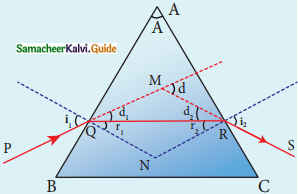
4. Total angle of deviation d produced is
d = d1 + d2
Substituting for d1 and d2,
d = (i1 – r1) + (i2 – r2)
After rearranging,
5. d = (i1 + i2) – (r1 + r2)
In the quadrilateral AQNR, two of the angles (at the vertices Q and R) are right angles. Therefore, the sum of the other angles of the quadrilateral is 180°.
6. ∠A + ∠QNR = 180°
From the triangle ∆ QNR,
r1 + r2 + ∠QNR = 180°
Comparing these two equations and we get,
r1 + r2 = A
substituting this in equation (6.98) for angle of deviation,
d = i1 + i2 – A
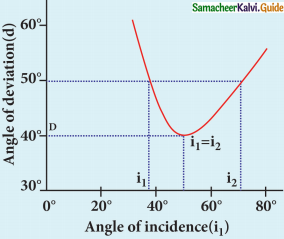
7. A graph plotted between the angle of incidence and angle of deviation.
8. The minimum value of angle of deviation is called the angle of minimum deviation D. At minimum deviation,
(a) the angle of incidence is equal to the angle of emergence, i1 = i2
(b) the angle of refraction at face one and face two are equal, r1 = r2
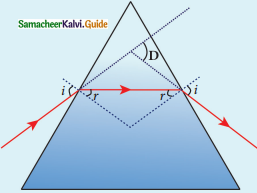
(c) the incident ray and emergent ray are symmetrical with respect to the prism.
(d) the refracted ray inside the prism is parallel to its base of the prism.
The case of the angle of minimum deviation is shown in figure
9. Refractive index of the material of the prism
At minimum deviation, i1 = i2 = i and r1 = r2 = r
D = i1 + i2 – A = 2i – A (or)
i = \(\frac{(\mathrm{A}+\mathrm{D})}{2}\)
r1 + r2 = A ⇒ 2r = A (or)
r = \(\frac{\mathrm{A}}{2}\)
n = \(\frac{\sin i}{\sin r}\)
n = \(\frac{\sin \left(\frac{A+D}{2}\right)}{\sin \left(\frac{A}{2}\right)}\)
Question 11.
What is dispersion? Obtain the equation for dispersive power of a medium.
Answer:
1. Dispersion is splitting of white light into its constituent colours. This band of colours of light is called its spectrum.
2. Consider a beam of white light passes through a prism; it gets dispersed into its constituent colours.
3. Let δV, δR are the angles of deviation for violet and red light. Let nv and nr are the refractive indices for the violet and red light respectively.
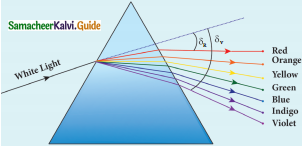
4. The refractive index of the material of a prism.
n = \(\frac{\sin \left(\frac{A+D}{2}\right)}{\sin \left(\frac{A}{2}\right)}\)
Here A is the angle of the prism and D is the angle of minimum deviation.
n = \(\frac{\sin \left(\frac{A+\delta}{2}\right)}{\sin \left(\frac{A}{2}\right)}\)
For small angles of A and δm,
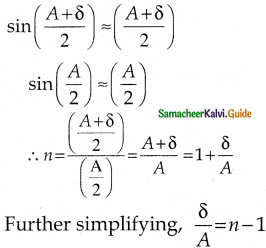
δ = (n – 1) A
Whn white light enters the prism, the deviation is different for different colours. Thus, the refractive index is also different for different colours.
For violet light, δ =(nv – 1) A
For Red light, δR =(nR – 1) A
5. As, angle of deviation for violet colour δv is greater than the angle of deviation for red colour, δv the refractive index for violet colour nv is greater than the refractive index for red colour nR.
Subtracting δv from δR we get,
δv – δR = (nv – nR) A
6. The term (δv – δR) is the angular separation between the two extreme colours (violet and red) in the spectrum is called angular dispersion. Clearly, the angular dispersion produced by a prism depends upon.
(i) Angle of the prism
(ii) Nature of the material of the prism.
7. It is defined as the ratio of the angular dispersion for the extreme colours to the deviation for any mean colour.
Dispersive power (ω),
ω = \(\frac{\text { angular dispersion }}{\text { mean deviation }}=\frac{\delta_{\mathrm{v}}-\delta_{\mathrm{R}}}{\delta}\)
Substituting for (δv – δR) and (δ),
ω = \(\frac{\left(n_{\mathrm{v}}-n_{R}\right)}{(n-1)}\)
Question 12.
Prove laws of reflection using Huygen’s principle.
Answer:
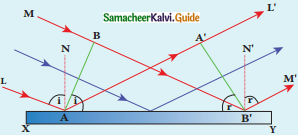
Laws of Reflection
1. Let us consider a parallel beam of light, incident on a reflecting plane surface such as a plane mirror XY.
2. The incident wavefront is A’B’ and the reflected wavefront is AB in the same medium.
3. These wavefronts are perpendicular to the incident rays L, M and reflected rays L ‘, M’ respectively.
4. By the time point A of the incident wavefront touches the reflecting surface, the point B is yet to travel a distance BB’ to touch the reflecting surface B’.
5. When point B falls on the reflecting surface at B’, the point A would have reached A’. This is applicable to all the points on the wavefront.
6. Thus, the reflected wavefront A’B’ emanates as a plane wavefront. The two normals N and N’ are considered at the points where the rays L and M fall on the reflecting surface. As reflection happens in the same medium, the speed of light is same before and after the reflection.
7. Hence, the time taken for the ray to travel from B to B’ is the same as the time taken for the ray to travel from A to A’. Thus, the distance BB’ is equal to the distance AA’ (AA’ = BB’)
(i) The incident rays, the reflected rays the normal are in the same plane.
(ii) Angle of incidence,
∠ i = ∠ NAL = 90° – ∠ NAB = ∠ BAB’
Angle of reflection,
∠ r =∠ N’B’M’ = 90° – ∠ N’B’A’=∠ A’B’A
8. For the two right angle triangles, ∆ ABB’ and ∆ B’A’A, the two triangles are congruent. As per the property of congruency; the two angles, ∠ BAB’ and ∠ A’B’A must also be equal.
i = r
hence the laws of reflection is proved.
![]()
Question 13.
Prove laws of refraction using Huygen’s principle.
Answer:
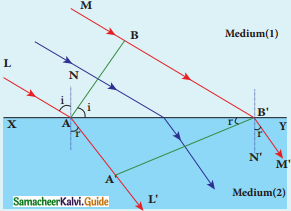
Law of refraction
1. Let us consider a parallel beam of light is incident on a refracting plane surface XY such as a glass surface.
2. The incident wavefront AB is in rarer medium (1) and the refracted wavefront ” AB is in denser medium (2).
3. These wavefronts are perpendicular to the incident rays L, M and refracted rays L’, M’ respectively.
4. By the time the point A of the incident wavefront touches the refracting surface, the point B is yet to travel a distance BB’ to touch the refracting surface at B’.
5. When point B falls on the refracting surface at, B, the point A would have reached A’ in the other medium.
6. The time taken t for the ray to travel from B to B is the same as the time taken for the ray to travel from A to A’
t = \(\frac{B B^{\prime}}{\mathrm{v}_{1}}=\frac{A A^{\prime}}{\mathrm{v}_{2}}\) (or)
t = \(\frac{B B^{\prime}}{A A^{\prime}}=\frac{v_{1}}{v_{2}}\)
(i) The incident rays, the refracted rays and the normal are in the same plane.
(ii) Angle of incidence,
i = ∠ NAL = 90° – ∠NAB = ∠ BAB’
Angle of refraction,
r = ∠N’B’M’= 90° – ∠N’B’A’ = ∠ A’B’A
7. For the two right angle triangle ABB’ and B’A’A,
\(\frac{\sin i}{\sin r}=\frac{B B^{\prime} / A B^{\prime}}{A A^{\prime} / A B^{\prime}}=\frac{B B^{\prime}}{A A^{\prime}}=\frac{\mathrm{v}_{1}}{\mathrm{v}_{2}}=\frac{c / \mathrm{v}_{2}}{c / \mathrm{v}_{1}}\)
8. Here, c is speed of light in vacuum. The ratio c/υ is the constant, called refractive index of the medium.
\(\frac{\sin i}{\sin r}=\frac{n_{2}}{n_{1}}\)
In product form,
n1 sin i = n2 sin r
Hence, the laws of refraction are proved.
Question 14.
Obtain the equation for resultant intensity due to interference of light.
Answer:
1. The phenomenon of addition or superposition of two light waves which produces increase in intensity at some points and a decrease in intensity at some other points is called interference of light.
2. Let us consider two light waves from the two sources S1 and S2 meeting at a point P as shown
3. The wave from S1 at an instant t and P is, y1 = a1 sin ωt
The wave from S2 an instant t at P is
y2 = a2 sin(ωt + Φ)
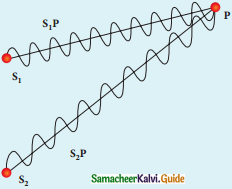
Superposition principle
4. The two waves have different amplitudes a1 and a2, same angular frequency ω’ and a phase difference of Φ between them. The resultant displacement will be given by.
y = y1 + y2 = a1 sin ωt + a1 sin2 (ωt + Φ) y = A sin (ωt + Φ)
Where, A =\(\sqrt{a_{1}^{2}+a_{2}^{2}+2 a_{1} a_{2} \cos \phi}\) ………….(1)
θ = \(\tan ^{-1} \frac{a_{2} \sin \phi}{a_{1}+a_{2} \cos \phi}\) ………….(2)
5. The resultant amplitude is maximum.
Amax = \(\sqrt{\left(a_{1}+a_{2}\right)^{2}}\);
when Φ = 0, ±2π, ± 4π …………….(3)
6. The resultant amplitude is minimum.
Amin = \(\sqrt{\left(a_{1}-a_{2}\right)^{2}}\);
when Φ = 0, ±π, ± 3π ± 5π ………..(4)
7. The intensity of light is proportional to the square of amplitude.
8. I α A2 ……………(5)
Now equation (1) becomes
I α I1 + I2 + 2\(\sqrt{I_{1} I_{2}}\) cos Φ ………….(6)
9. If the phase difference, Φ = 0, ± 2π, ± 4π., it corresponds to the condition for maximum intensity of light called as constructive interference.
10. The resultant maximum intensity is,
Imax α (a1 + a2)2 ……………….(7)
11. If the phase difference, Φ = + π, ± 3π, ± 5π …., it corresponds to the condition for the minimum intensity of light called destructive interference.
12. The resultant minimum intensity is Imin α
(a1 – a2)2 α I1 + I2 – 2\(\sqrt{\mathrm{I}_{1} \mathrm{I}_{2}}\) ………….(8)
As a special case, if a1 = a2 = a, then equation (1) becomes,
A = \(\sqrt{2 a^{2}+2 a^{2} \cos \phi}\)
= \(\sqrt{2 a^{2}(1+\cos \phi)}\)
= \(\sqrt{2 a^{2} 2 \cos ^{2}(\phi / 2)}\)
13. A = 2 a cos(Φ/2) ……….(9)
I α 4a2 cos2 (Φ/2) [∴ I α A2] …………(10)
I α 4 I0 cos2 (Φ/ 2) [ΦI0 α a2] ……….(11)
IMax = 4I0 when, Φ = o, ± 2π, 4π ……………(12)
Imin = 0 when, Φ = ± π, ± 3π, ± 5π ……………..(13)
Conclusion:
The phase difference between the two waves decides the intensity of light meet at a point.
![]()
Question 15.
Explain Young’s double-slit experimental setup and obtain the equation for path difference.
Answer:
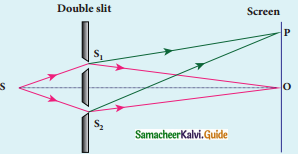
Young’s double slit experiment
1. Wavefronts from S1 and S2 spread out and overlapping takes place to the right side of double slit.
2. When a screen is placed at a distance of about 1 meter from the slits, alternate bright and dark fringes which are equally spaced appear on the screen. These are called interference fringes or bands.
Equation for path difference:
3. The Let d be the distance between the double slits S1 and S2 which act as coherent sources of wavelength λ.
4. A screen is placed parallel to the double slit at a distance D from it. The mid-point of S1 and S2 is C and the mid-point of the screen O is equidistant from S1 and S2. P is any point at a distance y from O.
5. The waves from S1 and S2 meet at P either in-phase or out-of-phase depending upon the path difference between the two waves.
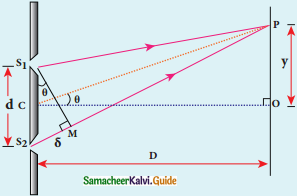
Young’s double slit experiment setup.
δ = S2P – S1P
δ = S2P – MP = S2M
6. The angular position of the point P from C is θ. ∠ OCP = θ.
7. From the geometry, the angles ∠ OCP and ∠ S2S1M are equal.
∠ OCP = ∠ S2S1M = θ.
In right angle triangle ∆ S1S2M, the path difference,
S2M = d sin θ
δ = d sin θ
If the angle θ is small, sin θ »tan θ θ
From the right angle triangle ∆ OCP,
tan θ = \(\frac{\mathrm{y}}{\mathrm{D}}\)
The path difference, δ = \(\frac{\mathrm{d} \mathrm{y}}{\mathrm{D}}\)
Question 16.
Obtain the equation for bandwidth in Young’s double slit experiment.
Answer:
Condition for bright fringe (or) maxima:
The condition for the constructive interference or the point P to be have a bright fringe is,
Path difference, δ = nλ
where, n = 0,1,2,…….. ∴ \(\frac{\mathrm{d} \mathrm{y}}{\mathrm{D}}\) = nl
y = n\(\frac{\lambda D}{d}\) (or)
yn = n\(\frac{\lambda D}{d}\)
Condition for dark fringe (or) minima:
The condition for the destructive interference or the point P to be have a dark fringe is,
Path difference δ = (2n -1) \(\frac{\lambda}{2}\)
when, n = 1, 2, 3,………..
∴ \(\frac{d y}{D}\) =(2n-l) \(\frac{\lambda}{2}\)
y = \(\frac{(2 n-1)}{2} \frac{\lambda D}{d}\) (or)
yn = \(\frac{(2 n-1)}{2} \frac{\lambda D}{d}\)
Equation for bandwidth:
1. The bandwidth (β) is defined as the distance between any two consecutive bright or dark fringes.
2. The distance between (n+l)th and nth consecutive brigh fringes from O is given by,
β = y(n + 1) – yn ((n + 1) \(\frac{\lambda D}{d}\)) – (n\(\frac{\lambda D}{d}\))
β = \(\frac{\lambda D}{d}\)
![]()
Question 17.
Obtain the equations for constructive and destructive interference for transmitted and reflected waves in thin films.
Answer:
Interference in thin films:
1. Let us consider a thin film of transparent material of refractive index p and thickness d. A parallel beam of light is incident on the film at an angle i.
2. The wave is divided into two parts at the upper surface, one is reflected and the other is refracted. The refracted part, which enters into the film, again gets divided at the lower surface into two parts; one is transmitted out of the film and the other is reflected back into the film.
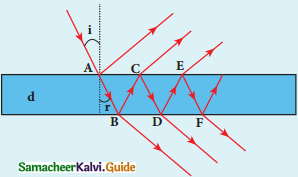
Interference in thin films
For transmitted light:
1. The light transmitted may interfere to produce a resultant intensity. Let us consider the path difference between the two light waves transmitted from B and D. The two waves moved together and remained in phase up to B where splitting occurred.
2. The extra path travelled by the wave transmitted from D is the path inside the film, BC + CD. If we approximate the incidence to be nearly normal (i = 0), then the points B and D are very close to each other. The extra distance travelled by the wave is approximately twice thickness of the film, BC + CD = 2d. As this extra path is travelled in a medium of refractive index p, the optical path difference is,
δ = 2μd.
3. The condition for constructive interference in transmitted ray is,
2μd = nλ
Similarly, the condition for destructive interference in transmitted ray is
2μd = (2n-l) \(\frac{\lambda}{2}\)
For reflected light:
1. Wave while travelling in a rarer medium and getting reflected by a denser medium, undergoes a phase change of n or an additional path difference of \(\frac{\lambda}{2}\).
2. Let us consider the path difference between the light waves reflected by the upper surface at A and the other wave coming out at C after passing through the film.
3. The additional path travelled by wave coming out from C is the path inside the film, AB + BC. For nearly normal incidence this distance could be approximated as, AB + BC = 2d. As this extra path is travelled in the medium of refractive index p, the optical path difference is, δ = 2μd.
4. The condition for constructive interference for reflected ray is,
2μd + \(\frac{\lambda}{2}\) = nλ (or)
2μd = (2n – 1) \(\frac{\lambda}{2}\)
5. The additional path difference λ/2 is due to the phase change of n in rarer to denser reflection taking place at A. The condition for destructive interference for reflected ray is,
2μd + \(\frac{\lambda}{2}\) = (2n + l)\(\frac{\lambda}{2}\) (or)
2μd = nλ
Question 18.
Discuss diffraction at single slit and obtain the condition for nth minimum.
Answer:
1. Let a parallel beam of light fall normally on a single slit AB of width. The diffracted beam falls on a screen kept at a distance. The center of the slit is C. A straight line through C perpendicular to the plane of slit meets the center of the screen at O.
2. All the waves start parallel to each other from different points of the slit and interfere at point P and other points to give the resultant intensities. The point P is in the geometrically shadowed region, up to which the central maximum is spread due to diffraction.
Condition for P to be first minimum:
1. Let us divide the slit AB into two half’s AC and CB. Now the width of AC is (a/2). They are called corresponding points.
2. The path difference of light waves from different corresponding points meeting at point P and interfere destructively to make it first minimum.
3. The path difference δ between waves from these corresponding points is,
δ = \(\frac{a}{2}\) sin θ
The Condition for P to be first minimum,
\(\frac{a}{2}\) sin θ = \(\frac{\lambda}{2}\)
a sin θ = λ (first minimum)
Condition for P to be nth order minimum:
Dividing the slit into 2n number of (even number of) equal parts the condition for nth order minimum is
\(\frac{a}{2 n}\) sin θ = \(\frac{\lambda}{2}\)
a sin θ = nλ (nth minimum)
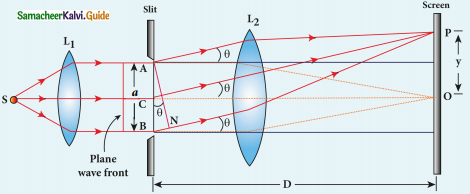
Diffraction at single slit
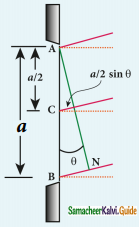
Corresponding points
![]()
Question 19.
Discuss the diffraction at a grating and obtain the condition for mth maximum.
Answer:
1. Grating has multiple slits with equal widths of size comparable to the wavelength of diffracting light.
2. Grating is a plane sheet of transparent material on which opaque rulings are made with a fine diamond pointer.
3. The rulings act as obstacles having a definite width b and the transparent space between the rulings act as slit of width a.
4. The combined width of a ruling and a slit is called grating element (e = a + b). Points on successive slits separated by a distance equal to the grating element are called corresponding points.
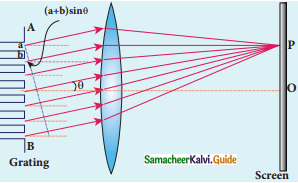
Diffraction grating experiment
5. Let a plane wavefront of monochromatic light with wave length λ be incident normally on the grating.
6. As the slits size is comparable to that of wavelength, the incident light diffracts at the grating.
7. A diffraction pattern is obtained on the screen when the diffracted waves are focused on a screen using a convex lens.
8. The path difference δ between the diffracted waves from one pair of corresponding points is,
δ = (a + b) sin θ
This path difference is the same for any pair of corresponding points. The point P will be bright, when
δ = mλ where m = 0,1,2,3
Combining the above two equations, we get,
(a + b) sin θ = mλ
Here, m is called an order of diffraction.
Condition for zero order maximum, m = 0
For (a + b) sinθ = 0, the position, θ = 0. sin θ = 0 and m = 0. This is called zero order diffraction or central maximum.
Condition for first-order maximum, m = 1
If (a + b) sin θ1 = λ, the diffracted light meet at an angle θ1 to the incident direction and the first-order maximum is obtained.
Condition for second-order maximum, m = 2
Similarly, (a + b) sin θ2 = 2λ forms the second-order maximum at the angular position θ2.
Condition for higher-order maximum
On either side of central maxima, different higher orders of diffraction maxima are formed at different angular positions.
If we take,
N = \(\frac{1}{a+b}\)
\(\frac{1}{\mathrm{~N}}\) sin θ = mλ (or) sin θ = Nmλ
Question 20.
Discuss the experiment to determine the wavelength of monochromatic light using diffraction grating.
Answer:
1. The wavelength of a spectral line can be very accurately determined with the help of a diffraction grating and a spectrometer.
2. Initially all the preliminary adjustments of the spectrometer are made.
3. The slit of collimator is illuminated by a monochromatic light, whose wavelength is to be determined.
4. The telescope is brought in line with a collimator to view the image of the slit.
5. The given plane transmission grating is then mounted on the prism table with its plane perpendicular to the incident beam of light coming from the collimator
6. The telescope is turned to one side until the first-order diffraction image of the slit coincides with the vertical cross wire of the eyepiece.
7. The reading of the position of the telescope is noted.
8. Similarly the first-order diffraction image on the other side is made to coincide with the vertical cross wire and corresponding reading is noted. The difference between the two positions gives 2θ.
9. Half of its value gives θ, the diffraction angle for first-order maximum. The wavelength of light
λ = \(\frac{\sin \theta}{\mathrm{Nm}}\)
10. Here, N is the number of rulings per metre in the grating and m is the order of the diffraction image.
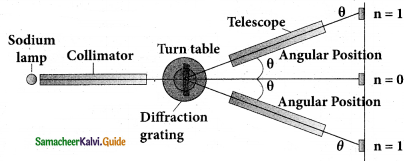
Determination of wavelength using grating and spectrometer
![]()
Question 21.
Discuss the experiment to determine the wavelength of different colours using diffraction grating.
Answer:
1. When white light is used, the diffraction pattern consists of a white central maximum and on both sides, continuous coloured diffraction patterns are formed.
2. The central maximum is white as all the colours meet here constructively with no path difference. As θ increases, the path difference, (a+b)sin θ, passes through the condition for maxima of diffraction of different orders for all colours from violet to red.
3. It produces a spectrum of diffraction pattern from violet to red on either side of central maximum
4. By measuring the angle at which these colours appear for various orders of diffraction, the wavelength of different colours could be calculated using the formula,
\(\lambda=\frac{\sin \theta}{\mathrm{Nm}}\)
Here, N is the number of rulings per metre in the grating and m is the order of the diffraction image.
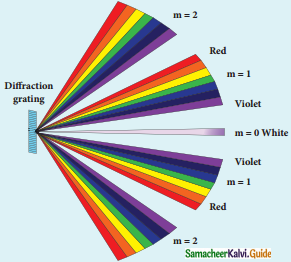
Diffraction with white light
Question 22.
Obtain the equation for resolving power of optical instrument.
Answer:
1. For a single rectangular slit, the half-angle θ subtended by the spread of central maximum is given by the relation,
a sin θ = λ
2. Similar to a rectangular slit, when a circular aperture or opening forms an image of a point object, the image formed will not be a point but a diffraction pattern of concentric circles that become fainter while moving away from the centre. These are known as Airy’s discs. The circle of central maximum has the half angular spread given by the equation,
a sin θ = 1.22 λ
3. The numerical value 1.22 comes for central maximum formed by circular apertures.
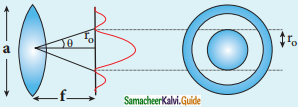
Airy’s disc
For small angles, sin θ ≈ θ
a θ =1.22 λ
Rewriting further,
θ = 1.22 λ/a and
\(\frac{\mathrm{r}_{0}}{\mathrm{f}}=\frac{1.22 \lambda}{\mathrm{a}}\)
r0 = \(\frac{1.22 \lambda f}{\mathrm{a}}\)
4. This equation is called spacial resolution.
5. When two-point sources close to each another form image on the screen, the diffraction pattern of one point source can overlap with another and produce a blurred image. To obtain a good image of the two sources, the two-point sources must be resolved i.e., the point sources must be imaged in such a way that their images are sufficiently far apart that their diffraction patterns do not overlap.
6. According to Rayleigh’s criterion, for two-point objects to be just resolved, the minimum distance between their diffraction images must be in such a way that the central maximum of one coincides with the first minimum of the other and vice versa. Such an image is said to be just resolved image of the object. The Rayleigh’s criterion is said to be limit of resolution.
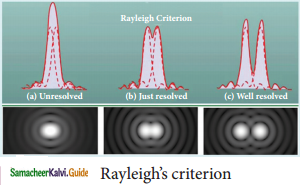
7. According to Rayleigh’s criterion the two-point sources are said to be just resolved when the distance between the two maxima is at least r0. The angular resolution has a unit in radian (rad) and it is given by the equation,
θ = \(\frac{1.22 \lambda}{\mathrm{a}}\)
8. The ability of an optical instrument to separate or distinguish small or closely adjacent objects through the image formation is said to be resolving power of the instrument.
![]()
Question 23.
Discuss about simple microscope and obtain the equations for magnification for near point focusing and normal focusing.
Answer:
1. A simple microscope is a single magnifying (converging) lens of small focal length The idea is to get an erect, magnified and virtual image of the object.
2. (1) Near point focusing – The image is formed at near point, i.e. 25 cm for normal eye. This distance is also called as least distance D of distinct vision. In this position, the eye feels comfortable but there is little strain on the eye.
3. (2) Normal focusing – The image is formed at infinity. In this position the eye is most relaxed to view the image.
> Object distance u is less than f. The image distance is the near point D. The magnification m is given by the relation,
m = \(\frac{\mathrm{v}}{\mathrm{u}}\)
4. With the help of lens equation,
\(\frac{1}{v}-\frac{1}{u}=\frac{1}{f}\) the magnification can further be written as,
m = 1 – \(\frac{v}{f}\)
5. Substituting for v with sign convention,
v = -D
6. m = 1 + \(\frac{\mathrm{D}}{f}\)
This is the magnification for near point focusing.
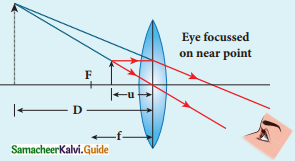
Near Point focusing
7. The angular magnification is defined as the ratio of angle θi subtended by the image with aided eye to the angle θ0 subtended by the object with unaided eye.
m = \(\frac{\theta_{i}}{\theta_{0}}\)

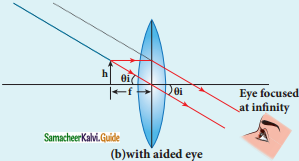
Normal focusing
8. For unaided eye shown in Figure (a),
tan θ0 ≈ θ0 = \(\frac{\mathrm{h}}{\mathrm{D}}\)
9. For aided eye shown in Figure (b),
tan θi ≈ θi = \(\frac{\mathrm{h}}{f}\)
10. The angular magnification is,
m = \(\frac{\theta_{i}}{\theta_{0}}=\frac{\mathrm{h} / \mathrm{f}}{\mathrm{h} / \mathrm{D}}\)
m = \(\frac{\mathrm{D}}{f}\)
This is the magnification for normal focusing.
Question 24.
Explain about compound microscope and obtain the equation for magnification.
Answer:
1. The lens near the object, called the objective, forms a real, inverted, magnified image of the object. This serves as the object for the second lens which is the eyepiece.
2. Eyepiece serves as a simple microscope that produces finally an enlarged and virtual image.
3. The first inverted image formed by the objective is to be adjusted close to, but within the focal plane of the eyepiece so that the final image is formed nearly at infinity or at the near point.
4. The final image is inverted with respect to the original object. We can obtain the magnification for a compound microscope.
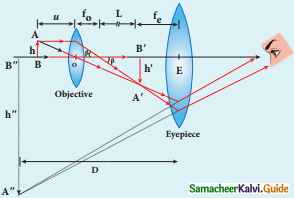
Compound microscope
5. From the ray diagram,
m0 = \(\frac{\mathrm{h}^{1}}{\mathrm{~h}}\)
tan β = \(\frac{\mathrm{h}}{\mathrm{f}_{0}}=\frac{\mathrm{h}^{1}}{\mathrm{~L}}\) then
\(\frac{\mathrm{h}^{\prime}}{\mathrm{h}}=\frac{\mathrm{L}}{\mathrm{f}_{\mathrm{o}}}\)
m0 = \(\frac{\mathrm{L}}{f_{0}}\)
Jo
6. Here, the distance L is between the first focal point of the eyepiece to the second focal point of the objective. This is called the tube length L of the microscope as f0 and fe are comparatively smaller than L.
7. If the final image is formed at P (near point focusing), the magnification me of the eyepiece is, D
me = 1 + \(\frac{\mathrm{D}}{f_{\mathrm{e}}}\)
8. The total magnification m in near point focusing is,
m = m0 me = \(\left(\frac{L}{f_{0}}\right)\left(1+\frac{D}{f_{e}}\right)\)
9. If the final image is formed at infinity (normal focusing), the magnification me of the eyepiece is,
me = \(\frac{\mathrm{D}}{\mathrm{f}_{\mathrm{e}}}\)
10. The total magnification m in normal focusing is,
m = m0 me = \(\left(\frac{\mathrm{L}}{f_{0}}\right)\left(\frac{\mathrm{D}}{f_{\mathrm{e}}}\right)\)
![]()
Question 25.
Obtain the equation for resolving power of microscope.
Answer:
1. A microscope is used to see the details of the object under observation. The ability of microscope depends not only in magnifying the object but also in resolving two points on the object separated by a small distance dmin. Smaller the value of dmin better will be the resolving power of the microscope.
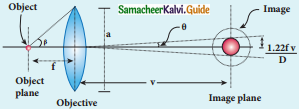
r0 = \(\frac{1.22 \lambda v}{a}\)
2. then the magnification m is,
m = \(\frac{\mathrm{r}_{0}}{\mathrm{~d}_{\min }}\)
dmin = \(\frac{r_{0}}{m}=\frac{1.22 \lambda v}{a m}=\frac{1.22 \lambda v}{a(v / u)}=\frac{1.22 \lambda u}{a}\)
[∴ m = v/u]
dmin = \(\frac{1.22 \lambda f}{a}\) [∴ u ≈f]
On the other side,
2 tan β ≈ 2 sin β = \(\frac{a}{f}\) ∴ [a = f 2sin β]
dmin = \(\frac{1.22 \lambda}{2 \sin \beta}\)
3. To further reduce the value of dmin the optical path of the light is increased by immersing the objective of the microscope into a bath containing oil of refractive index n.
dmin = \(\frac{1.22 \lambda}{2 n \sin \beta}\)
4. Such an objective is called oil immersed objective. The term n sin β is called numerical aperture NA.
d min = \(\frac{1.22 \lambda}{2(N A)}\)
Question 26.
Discuss about astronomical telescope.
Answer:
1. An astronomical telescope is used to get the magnification of distant astronomical objects like stars, planets, moon etc. the image formed by the astronomical telescope will be inverted.
2. It has an objective of long focal length and a much larger aperture than the eyepiece.
3. Light from a distant object enters the objective and a real image is formed in the tube at its second focal point.
4. The eyepiece magnifies this image producing a final inverted image.
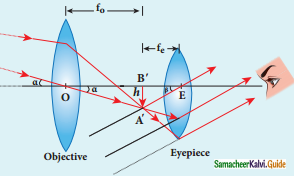
Astronomical Telescope
5. The magnification m is the ratio of the angle β subtended at the eye by the final image to the angle ∞ which the object subtends at the lens or the eye.
m = \(\frac{\beta}{\alpha}\)
From the diagram,
m = \(\frac{h / f_{e}}{h / f_{0}}\)
m = \(\frac{f_{0}}{f_{e}}\)
The length of the telescope is approximately, L = f0 +fe
![]()
Question 27.
Mention different parts of the spectrometer and explain the preliminary adjustments.
Answer:
The spectrometer is an optical instrument used to study the spectra of different sources of light and to measure the refractive indices of materials. It consists of basically three parts. They are
(i) collimator,
(ii) prism table and
(iii) Telescope.
(i) Collimator:
1. The collimator is an arrangement to produce a parallel beam of light. It consists of a long cylindrical tube with a convex lens at the inner end and a vertical slit at the outer end of the tube.
2. The distance between the slit and the lens can be adjusted such that the slit is at the focus of the lens. The slit is kept facing the source of light.
3. The width of the slit can be adjusted. The collimator is rigidly fixed to the base of the instrument.
(ii) Prism table:
1. The prism table is used for mounting the prism, grating etc. It consists of two circular metal discs provided with three levelling screws.
2. It can be rotated about a vertical axis passing through its centre and its position can be read with verniers V1 and V2. The prism table can be raised or lowered and can be fixed at any desired height.
(iii) Telescope:
1. The telescope is an astronomical type. It consists of an eyepiece provided with cross wires at one end and an objective lens at its other end.
2. The distance between the objective lens and the eyepiece can be adjusted so that the telescope forms a clear image at the cross wires when a parallel beam from the collimator is incident on it.
3. The telescope is attached to an arm which is capable of rotation about the same vertical axis as the prism table. A circular scale graduated in a half degree is attached to it.
4. Both the telescope and prism table is provided with radial screws for fixing them in a desired position and tangential screws for fine adjustments.
Adjustments of the spectrometer:
(a) Adjustment of the eyepiece:
The telescope is turned towards an illuminated surface and the eyepiece is moved to and fro until the cross wires are clearly seen.
(b) Adjustment of the telescope:
The telescope is adjusted to receive parallel rays by turning it towards a distant object and adjusting the distance between the objective lens and the eyepiece to get a clear image on the cross wire.
(c) Adjustment of the collimator:
The telescope is brought along the axial line with the collimator. The slit of the collimator is illuminated by a source of light. The distance between the slit and the lens of the collimator is adjusted until a clear image of the slit is seen at the cross wire of the telescope. Since the telescope is already adjusted for parallel rays, a well- defined image of the slit can be formed, only when the light rays emerging from the collimator are parallel.
(d) Levelling the prism table:
The prism table is adjusted or levelled to be in a horizontal position by means of levelling screws and a spirit level.
Question 28.
Explain the experimental determination of material of the prism using a spectrometer.
Answer:
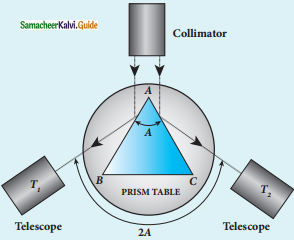
Angle of prism
1. The prism is placed on the prism table with its refracting edge facing the collimator.
2. The slit is illuminated by a sodium light (monochromatic light). The parallel rays coming from the collimator fall on the two faces AB and AC.
3. The telescope is rotated to the position T1 until the image of the slit formed by the reflection at the face AB is made to coincide with the vertical cross wire of the telescope.
4. The readings of the verniers are noted. The telescope is then rotated to the position T2 where the image of the slit formed by the reflection at the face AC coincides with the vertical cross wire. The readings are again noted.
5. The difference between these two readings gives the angle rotated by the telescope, which is twice the angle of the prism. Half of this value gives the angle of the prism A.
(ii) Angle of minimum deviation (D):
1. The prism is placed on the prism table so that the light from the collimator falls on a refracting face, and the refracted image is observed through the telescope. The prism table is now rotated so that the angle of deviation decreases.
2. A stage comes when the image stops for a moment and if we rotate the prism table further in the same direction, the image is seen to recede and the angle of deviation increases.
3. The vertical cross wire of the telescope is made to coincide with the image of the slit where it turns back. This gives the minimum deviation position.
Angle of Minimum deviation:
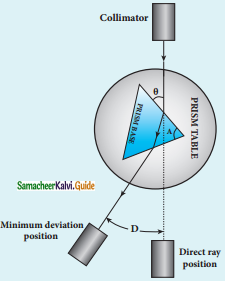
Angle of minimum deviation.
1. The readings of the verniers are noted. Now, the prism is removed, and the telescope is turned to receive the direct ray and the vertical cross wire is made to coincide with the image. The readings of the verniers are noted.
2. The difference between the two readings gives the angle of minimum deviation D. The refractive index of the material of the prism n is calculated using the formula,
n = \(\frac{\sin \left(\frac{A+D}{2}\right)}{\sin \left(\frac{A}{2}\right)}\)
![]()
IV. Conceptual Questions:
Question 1.
Why are dish antennas curved?
Answer:
In order to receive parallel signal rays coming from same direction to fall on a single point; its focus where the receiver is placed.
Question 2.
What type of lens is formed by a bubble inside water?
Answer:
Air bubble has spherical surface and is surrounded by medium (water) of higher refractive index. When light passes from water to air, it gets diverged. So it behaves as a concave lens.
Question 3.
Is it possible for two lenses to produce zero power? Explain.
Answer:
- Yes, possible
- If one lens is converging lens with some focal length so that its power is P1 = P.
- The other lens is a diverging lens with the same focal length with a negative sign, so that its power is P2 = -P.
- The combination of these two lenses is given by
Ptotal = P1 + P2 = P + (-P)
P = 0
Question 4.
Why does the sky look blue and clouds look white?
Answer:
- Blue colour of the sky is due to scattering of sunlight by air molecules. According to Rayleigh’s law, I α \(\frac{1}{\lambda^{4}}\) So blue light (λmin) is scattered much more.
- Clouds have large particles like dust and water droplets which scatter light of all colours almost equally. Hence clouds generally appear white.
Question 5.
Why is yellow light preferred to during fog?
Answer:
Yellow light has longer wavelength than green, blue or violet components of white light. According to Rayleigh scattering law yellow colour is least scattered and produces sufficient illumination.
![]()
Question 6.
Two independent monochromatic sources cannot act as coherent sources. Why?
Answer:
- Two independent monochromatic sources emit waves of the same wavelength. But the waves are not in phase. So they are not coherent.
- This is because atoms cannot emit light waves in same phase.
Question 7.
Does diffraction take place at Young’s double-slit?
Answer:
Yes, light waves arriving at each slit are diffracted and then diffracted waves interfere to produce interference pattern.
Question 8.
Is there any difference between coloured light obtained from prism and colours of soap bubble?
Answer:
- Coloured light obtained from prism is due to the phenomenon of dispersion.
- Colours of soap bubble are due to interference of light waves from the upper and lower surface of the soap film.
Question 9.
A small disc is placed in the path of the light from distance source. Will the center of the shadow be bright or dark?
Answer:
Waves diffracted from the edge of circular obstacle interfere constructively at the center of the shadow resulting in the formation of a bright spot.
Question 10.
When a wave undergoes reflection at a denser medium, what happens to its phase?
Answer:
Its phase changes at 180 degrees.
![]()
V. Numerical problems:
Question 1.
An object is placed at a certain distance from a convex lens of focal length 20 cm. Find the distance of the object if the image obtained is magnified 4 times.
Answer:
Given:
f = 20 cm
m = -4 = \(\frac{v}{u}\)
v = -4u
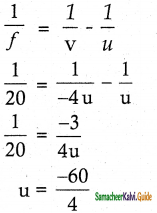
u = -15 cm
Question 2.
A compound microscope has a magnification of 30. The focal length of eyepiece is 5 cm. Assuming the final image to be at least distance of distinct vision, find the magnification produced by the objective.
Answer:
me = \(\frac{v}{u}=\frac{\mathrm{D}}{\mathrm{u}_{e}}=1+\frac{\mathrm{D}}{f_{\mathrm{e}}}\)
= 1 + \(\frac{25}{5}\)
= 6
for compound microscope,
m = m0 × me
30 = m0 × 6
m0 = \(\frac{30}{6}\) = 5
Question 3.
An object is placed in front of a concave mirror of focal length 20 cm. The image formed is three times the size of the object. Calculate two possible distances of the object from the mirror.
Answer:
First case when the image is virtual, m = 3
m = \(-\frac{v}{u}\)
3 = \(-\frac{v}{u}\)
v = -3u
\(\frac{1}{f}=\frac{1}{u}+\frac{1}{v}\)
\(-\frac{1}{20}=\frac{1}{u}-\frac{1}{3 u}\)
\(\frac{3 \mathrm{u}}{4}\) = – 20
3u = -40
u = –\(\frac{40}{3}\) cm
Second case when the image is real
m = -3
m = \(-\frac{\mathrm{v}}{\mathrm{u}}\)
-3 = \(-\frac{v}{u}\)
V = 3u
\(\frac{1}{f}=\frac{1}{\mathrm{u}}+\frac{1}{\mathrm{v}}\)
\(-\frac{1}{20}=\frac{1}{u}+\frac{1}{3 u}\)
\(\frac{3 \mathrm{u}}{4}\) = -20
u = – \(\frac{80}{3}\) cm
![]()
Question 4.
A small bulb is placed at the bottom of a tank containing water to a depth of 80 cm. What is the area of the surface of water through which light from the bulb can emerge out? Refractive index of water is 1.33. (Consider the bulb to be a point source.)
Answer:
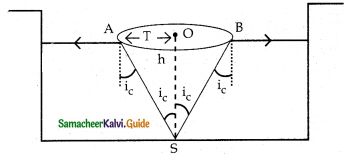
The light rays from the small bulb S which are incident at an angle i > ic are totally internally reflected and cannot emerge out of water surface. The light from the bulb ‘S’ comes out through a circles path of radius r is given by
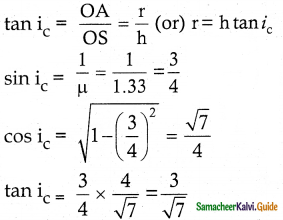
Area of the patch = πr²
= π h2 tan2 ic
= 3.14 × 0.802 × \(\frac{9}{7}\)
= 2.58 m2
≈ 2.6 m2
Question 5.
A thin converging glass lens made of glass with refractive index 1.5 has a power of + 5.0 D. When this lens is immersed in a liquid of refractive index n, it acts as a divergent lens of focal length 100 cm. What must be the value of n?
Answer:
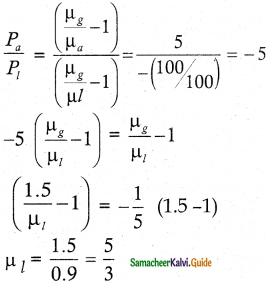
![]()
Question 6.
If the distance D between an object and screen is greater than 4 times the focal length of a convex lens, then there are two positions of the lens for which images are formed on the screen. This method is called conjugate foci method. If d is the distance between the two positions of the lens, obtain the equation for focal length of the convex lens.
Answer:
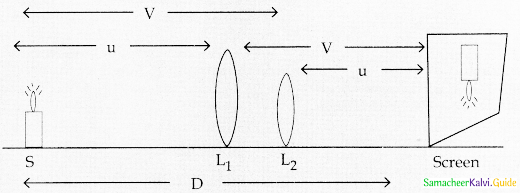
seperation between object screen is
D = u + v
m1 = \(\frac{\mathrm{V}}{\mathrm{u}}\);
m2 = \(\frac{u}{v}\)
m1m2 = 1
size of image 1 = m1 times the size of object
SI1 = m1S0
SI2 = m2S0
S0 = \(\sqrt{\mathrm{S}_{\mathrm{I}_{1}} \mathrm{~S}_{\mathrm{I}_{2}}}\)
here distance between its two positions of lens where sharp images are obtained
d = v – u
focal length of lens f = \(\frac{\mathrm{uv}}{\mathrm{u}+\mathrm{v}}\)
= \(\frac{(u+v)^{2}-(u-v)^{2}}{4(u+v)}\)
f = \(\frac{\mathrm{D}^{2}-\mathrm{d}^{2}}{4 \mathrm{D}}\)
when D > 4f
Question 7.
A beam of light of wavelength 600 nm from a distant source falls on a single slit 1 mm wide and the resulting diffraction pattern is observed on a screen 2 m away. What is the distance between the first dark fringe on either side of the central bright fringe?
Answer:
β = \(\frac{\lambda D}{d}\)
d = 1mm
λ = 600 × 10-9 m
D = 2m
= \(\frac{6 \times 10^{2} \times 10^{-9} \times 2}{1 \times 10^{-3}}\)
= 1.2 mm
Distance between two dark fringes which are on either side of the central bright fringe = 2 × 1.2 mm = 2.4 mm
Question 8.
In Young’s double-slit experiment, the slits are 2 mm apart and are illuminated with a mixture of two-wavelength λ0 = 750 nm and λ = 900 nm. What is the minimum distance from the common central bright fringe on a screen 2 m from the slits where bright fringe from one interference pattern coincides with a bright fringe from the other?
Answer:
Let n1 bright fringe of λ1 coincides with (n+1) bright fringe of λ2.
\(\frac{\mathrm{n} \lambda_{1} \mathrm{D}}{\mathrm{d}}=\frac{(\mathrm{n}+1) \lambda_{2} \mathrm{D}}{\mathrm{d}}\)
n × 900 × 10-9 = (n + 1) × 750 ×10-9
minimum distance from central maxima = \(\frac{\mathrm{n} \lambda_{1} \mathrm{D}}{\mathrm{d}}\)
= \(\frac{5 \times 900 \times 10^{-9} \times 2}{2 \times 10^{-3}}\)
= 4.5 mm
Question 9.
In Young’s double-slit experiment, 62 fringes are seen in the visible region for sodium light of wavelength 5893 Å. If violet light of wavelength 4359 Å is used in place of sodium light, then what is the number of fringes seen? Answer:
n1λ1 = n2 λ2
62 × 5893 A° = n2 × 4358 A°

Question 10.
A compound microscope has a magnifying power of 100 when the image is formed at infinity. The objective has a focal length of 0.5 cm and the tube length is 6.5 cm. What is the focal length of the eyepiece?
Answer:
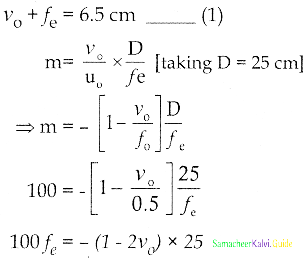
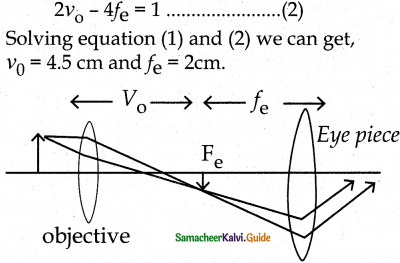
![]()
Part – II:
12th Physics Guide Optics Additional Questions and Answers
I. Matching type Questions:
Question 1.
Match the column – I and column – II:
| Column I | Column – II |
| A) An object is placed at focus before a convex mirror | Magnification is -∞ |
| B) An object is placed at centre of curvature before a concave mirror | Magnification is 0.5 |
| C) An object is placed at focus before a concave mirror | Magnification is +1 |
| D) An object is placed at centre of curvature before a convex mirror | Magnification is 0.33 |
a) (A) → (2); (B) → (3); (C) → (4); (D) → (1)
b) (A) → (2); (B) → (4); (C) → (3); (D) → (1)
c) (A) → (2); (B) → (4); (C) → (1); (D) → (3)
d) (A) → (3); (B) → (1); (C) → (2); (D) → (4)
Answer:
c) (A) → (2); (B) → (4); (C) → (1); (D) → (3)
Question 2.
Match the column – I and column – II:
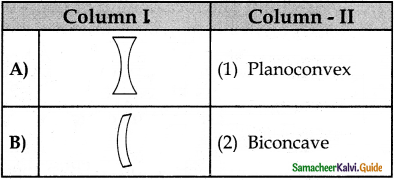
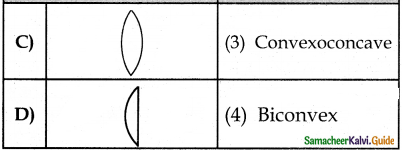
a) (A) → (3); (B) → (1); (C) → (2); (D) → (4)
b) (A) → (2); (B) → (3); (C) → (4); (D) → (1)
c) (A) → (2); (B) → (4); (C) → (3); (D) → (1)
d) (A) → (3); (B) → (2); (C) → (1); (D) → (4)
Answer:
b) (A) → (2); (B) → (3); (C) → (4); (D) → (1)
Question 3.
Match the column – I and column – II:
| Column I | Column – II |
| A) Mirage | (1) Refraction of light |
| B) Apparent depth of object is lesser than the actual depth in water | (2) Scattering of sun Light |
| C) Blue colour of sky | (3) Total internal reflection |
| D) The formation of rainbow | (4) Dispersion of sunlight |
a) (A) → (2); (B) → (3); (C) → (4); (D) → (1)
b) (A) → (3); (B) → (4); (C) → (1); (D) → (2)
c) (A) → (4); (B) → (1); (C) → (2); (D) → (3)
d) (A) → (3); (B) → (1); (C) → (2); (D) → (4)
Answer:
d) (A) → (3); (B) → (1); (C) → (2); (D) → (4)
Question 4.
Match the Column I and Column II:
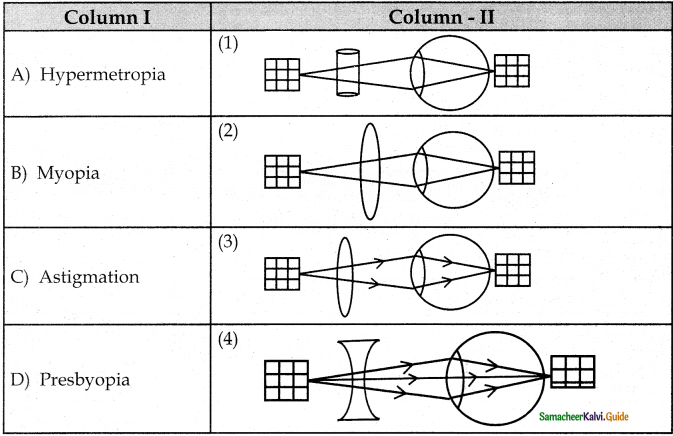
a) (A) → (3); (B) →(1); (C) → (2); (D) →(4)
b) (A) → (4); (B)→ (3); (C) →(2); (D) → (1)
c) (A) →(1); (B) → (2); (C) → (3); (D) → (4)
d) (A) → (3); (B)→ (4); (C) → (1); (D) → (2)
Answer:
d) (A) → (3); (B)→ (4); (C) → (1); (D) → (2)
![]()
II. Assertion – Reason type Question:
Directions:
Each of these questions contains two statements, Assertion and Reason. Each of these also has four alternative choices, only one of which is the correct answer. You have to select one of the code (a), (c) and (d) given below.
a) Assertion is correct, reason is correct, reason is a correct explanation for assertion
b) Assertion is correct, reason is correct, reason is not a correct explanation for assertion
c) Assertion is correct, reason is incorrect.
d) Assertion is incorrect, reason is correct
Question 1.
Assertion:
The plane mirror may form a real image.
Reason:
The plane mirror forms virtual image, if object is real.
Answer:
b) Assertion is correct, reason is correct, reason is not a correct explanation for assertion
Question 2.
Assertion:
The focal length of the convex mirror will increase if the mirror is placed in water.
Reason:
The focal length of a convex mirror of radius R is equal to f = R/2.
Answer:
d) Assertion is incorrect, reason is correct
Question 3.
Assertion:
The image formed by a concave mirror is certainly real if the object is virtual.
Reason:
The image formed by a concave mirror is certainly virtual if the object is real.
Answer:
c) Assertion is correct, reason is incorrect.
Question 4.
Assertion:
The image of an extended object placed perpendicular to the principal axis of a mirror, will be erect if the object is real but the image is virtual.
Reason:
The image of an extended object placed perpendicular to the principal axis of a mirror, will be erect if the object is virtual but the image is real.
Answer:
b) Assertion is correct, reason is correct, reason is not a correct explanation for an assertion.
![]()
III. Fill in the blanks:
Question 1.
The angle of a ray by a plane mirror or a plane surface is _________ the glancing angle.
Answer:
twice
Question 2.
Critical angle for diamond is _________.
Answer:
24° 41°
Question 3.
At minimum deviation position, the emergent ray is _________.
Answer:
Parallel to the base of the prism
Question 4.
Colours in thin films is due to _________.
Answer:
interference of light
![]()
IV. Graph Questions:
Question 1.
Figures shows two rays A and B being reflected by a mirror and going as A and B. The mirror
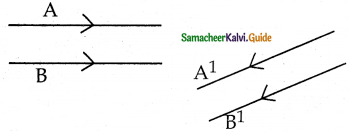
(a) is plane
(b) is convex
(c) is concave
(d) maybe any spherical mirror
Answer:
(a) is plane
Question 2.
Refraction of light from air to glass and from air to water is shown in figure (i) and figure (ii) below. The value of the angle – in the case of refraction as shown
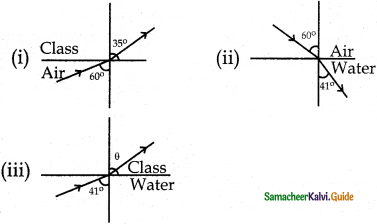
(a) 30°
(b) 35°
(c) 60°
(d) 41°
Answer:
(b) 35°
Solution:
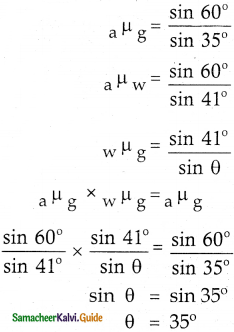
Question 3.
The following figure shows refraction of light at the interface of three media
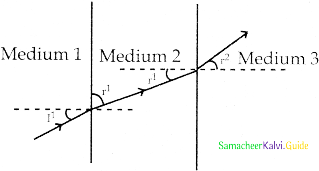
Correct the order of optical density (d) of the media is
(a) d1 > d2 > d3
(b) d2 > d1 > d3
(c) d3 > d1 > d2
(d) d2 > d3 > d1
Answer:
(d) d2 > d3 > d1
As r2 < i incident ray bend towards normal.
⇒ medium 2 is denser (or) r2 < i1
⇒ medium 3 is denser than medium 1, Also r2 > r1
⇒ medium 2 is denser than medium 3
![]()
V. Choose the Odd man out:
Question 1.
a) interference
b) diffraction
c) reflection
d) Photo electric effect
Answer:
(d) Photo electric effect explains particle nature while other phenomenon explains the wave nature of light.
Question 2.
a) Myopia
b) hypermetropia
c) Astigmatism
d) dispersion
Answer:
(d) dispersion other options are defects of eye.
Question 3.
a) Canada balsam
b) ordinary ray
c) extraordinary ray
d) grating
Answer:
(d) the grating is a component for diffraction while others related, to double reflection wave nature of light.
Question 4.
a) Sunglass
b) Holography
c) Spectrometer
d) 3D picture
Answer:
(c) Polaroids are used in sunglass, Holography, 3-D picture.
VI. Choose the correct pair:
Question 1.
| Column I | Column – II |
| i) Terrestrial telescope | (1) final image is erected |
| ii) Galileo’s telescope | (2) final image is inverted |
| iii) Reflecting telescope | (3) Use concave lens for the eyepiece to obtain an erected image |
| iv) Astronomical telescope | (4) No chromatic observation |
Answer:
i) Terrestrial _ (1) final image is telescope erected
Question 2.
| Column I | Column – II |
| i) Nice prism | (1) Cheap in cost due to availability of flawless calcite crystal |
| ii)Sky appear blue colour | (2) dispersion |
| iii) Polarisation | (3) Sunglass |
| iv) diamond | (4) total internal reflection |
Answer:
(iii) Polarisation – Sunglass
![]()
VII. Choose the Incorrect pair:
Question 1.
| Column I | Column – II |
| i) Interference of light | (1) Coherent source |
| ii) Brewster’s law | (2) μ = sin i/ sin r |
| iii) Diffraction of light | (3) Obstacle / aperture size = 1 |
| iv) Law of Malus | (4) I = Io cos2 θ |
Answer:
ii) Brewster’s law – μ = sin i / sin r
Question 2.
| Column I | Column – II |
| i) Reflection | (1) Change in the path of light without a change in medium |
| ii) Refraction | (2) μ = sin i / sin r |
| iii) Interference | (3) Fibre-optic communication |
| iv) Polarisation | (4) used for reducing glare. |
Answer:
iii) Interference – Fibre-optic communication.
VIII. Choose the correct Statement:
Question 1.
Which of the following statement about laws of reflection is / are correct?
I. The incident ray, the reflected ray and the normal all lie in the same plane.
II. Angle of incidence is equal to the angle of reflection.
III. After reflection, velocity, wavelength and frequency of light remains the same but intensity decreases.
Answer:
I, II and III
Question 2.
A convex mirror is used to form the image of an object, then which of the following statements is/ are true?
I. The image is lies between the pole and focus.
II. The image is diminished in size.
III. The image is real.
Answer:
I and II
Question 3.
A convex mirror is used to form the image of an object, then which of the following statements is/ are true?
I. Normal is taken as perpendicular of tangent at the point of incidence.
II. Perpendicular to incident ray which is perpendicular to the plane of incident ray.
III. Line joining centre of curvature of mirror with point of incidence.
IV. Line joining the centre of curvature and pole of curved surface.
Answer:
I and III
![]()
IX. Choose the incorrect Statement:
Question 1.
Which of the following statement is incorrect?
I. Light diverging from a point source is spherical.
II. Light emerging out of a convex lens when a point source is placed at its focus is plane..
III. the portion of wavefront of light from a distant star intercepted by the earth is plane.
Answer:
I only
Question 2.
Which of the following statement is incorrect?
I. A Polaroid consist of long-chain molecules aligned in a particular direction.
II. Electric vectors along the direction of the aligned molecule in a polaroid gets absorbed.
III. An unpolarized light wave is incident on polaroid. then it will not get linearly polarised.
Answer:
a) III only
Question 3.
Which of the following statement is incorrect?
The resolving power of telescope is limited by
I. focal length of objective lens
II. the diameter of objective lens
III. the wavelength of light used
IV. the thickness of objective lens
Answer:
I and IV
![]()
X. Choose the correct answer:
Question 1.
When a ray of light enters a glass slab from air
(b) its wavelength increases
(c) its frequency increases
(d) neither its wavelength nor its frequency changes
Answer:
(a) its wavelength decreases
Hint:
Wavelength, λ = \(\frac { Velocity }{ Frequency }\) = \(\frac { u }{ v }\)
When light travels from air to glass, frequency v remains unchanged, velocity u decreases and hence wavelength X also decreases.
Question 2.
If the light moving in a straight line bends but a small in fixed angle, it may be a case of
a) reflection
b) Frequency
c) Velocity
d) Amplitude
Answer:
d) Amplitude
Question 3.
The difference between reflection and total internal reflection is that
a) the laws of reflection hold true for reflection but not for total internal reflection
b) total internal reflection can take place only when light travels from a rarer medium to a denser medium while reflection can take place vice-versa also.
c) reflection can take place when light. travels from rarer medium to denser medium and vice-versa but total internal reflection can take place only when it travels from an optically denser to an optically rarer medium
d) reflection is a natural phenomenon while total internal reflection is man-made.
Answer:
c) reflection can take place when light travels from rarer medium to denser medium and vice-versa but total internal reflection can take place only when it travels from an optically denser to an optically rarer medium
Question 4.
When the angle of incidence of a light ray is greater than the critical angle it gets
a) critically refracted
b) totally reflected
c) total internally reflected
d) totally refracted
Answer:
c) total internally reflected
Question 5.
Which of the following is used in optical fibres?
(a) Total internal reflection
(b) Diffraction
(c) Refraction
(d) Scattering
Answer:
(a) Total internal reflection
Hint:
The working of optical fibres is based on total internal reflection.
![]()
Question 6.
The apparent flattening of the sun at sunset and sunrise is due
a) refraction
b) diffraction
c) total internal reflection
d) Interference
Answer:
a) refraction
Question 7.
The speed of light in an isotropic medium depends on
a) the nature of the source
b) its wavelength
c) its direction of propagation
d) its intensity
Answer:
b) its wavelength
Question 8.
Time image formed by an objective of a compound microscope is
(a) virtual and diminished
(b) real and diminished
(c) real and enlarged
(d) virtual and enlarged
Answer:
(c) real and enlarged
Hint:
The image formed by the objective of a compound microscope is real and enlarged.
Question 9.
The rays of different colours fail to converge at a point after going through a converging lens. This defect is called
a) spherical aberration
b) distortion
c) coma
d) chromatic aberration
Answer:
d) chromatic aberration
Question 10.
What causes chromatic aberration?
a) Marginal rays
b) Central rays
c) Difference in radii of curvature of its surfaces
d) Variation of focal length of lens with colour
Answer:
d) Variation of focal length of lens with colour
![]()
Question 11.
The focal length of a converging lens are fv and fR for violet and red light respectively. Then
a) fv > fR
b) fv = fR
c) fv < fR
d) any of the three is possible depending on the value of the average refraction index m
Answer:
c) fv < fR
Question 12.
A pencil of light rays falls on a plane mirror and forms a real image, so the incident rays are
(a) parallel
(b) diverging
(c) converging
(d) statement is false
Answer:
(c) converging
Hint:
When converging rays fall on a plane mirror, they get reflected a point d in front of the mirror forming a real image.
Question 13.
If a glass prism is dipped in water, its dispersive power
a) increases
b) decreases
c) does not change
d) may increase or decrease depending on whether the angle of the prism is less than or greater than 60°
Answer:
b) decreases
Question 14.
If D is the deviation of a normally falling light beam on a thin prism of angle A and δ is the dispersive power of the same prism then
a) D is independent of A
b) D is independent of refractive Index
c) δ is independent of refractive Index
d) δ is independent of A
Answer:
d) δ is independent of A
Question 15.
When white light enters a prism, it gets split into its constituent colours, This is due to
a) high density of prism material
b) because μ is different for different wavelength
c) diffraction of light
d) velocity changes for different frequency
Answer:
b) because μ is different for different wavelength
![]()
Question 16.
Yellow light is refracted through a prism producing minimum deviation. If i1 and i2 denote the angle of incidence and emergence for this prism, then
a) i1 = i2
b) i1 > i2
c) i1 < i2
d) i1 + i2 = 90°
Answer:
a) i1 = i2
Question 17.
The wavelength of sodium light in air is 5890 Å. The velocity of light in air is 3 x 108 ms-1. The wavelength of light in a glass of refractive index 1.6 would be close to
(a) 5890 Å
(b) 3681 Å
(c) 9424 Å
(d) 15078 Å
Answer:
(b) 3681 Å
Hint:
μ = \(\frac { { \lambda }_{ a } }{ { \lambda }_{ g } } \) ⇒λg= \(\frac { { \lambda }_{ a } }{ μ } \) = \(\frac { 5890 Å }{ 1.6 }\) = 3681 Å
Question 18.
The dispersive power of a prism depends on its
a) shape
b) size
c) angle of the prism
d) refractive index of the monitorial of the prism
Answer:
d) refractive index of the monitorial of the prism
Question 19.
The angle of prism is 60° and angle of deviation is 30°. In the position of minimum deviation, the values of angle of incidence and angle of emergence are:
a) i = 45°; e = 50°
b) i = 30°; e = 45°
c) i = 45°; e = 45°
d) i = 30°; e = 30°
Answer:
c) i = 45°; e = 45°
Question 20.
In primary rainbow what is the order of colors observed from earth?
a) Violet innermost, red outermost
b) Red innermost, violet outermost
c) Random
d) White and dark alternatively
Answer:
a) Violet innermost, red outermost
![]()
Question 21.
A point source of light is placed 4 m below the surface of water of refractive index 5/3. The minimum diameter of a disc which should be placed over the source, on the surface of water to cut-off all light coming out of water is
(a) infinite
(b) 6 cm
(c) 4 cm
(d) 3 cm
Answer:
(b) 6 cm
Hint:
r = \(\frac{h}{\sqrt{\mu^{2}-1}}\) = \(\frac{4}{\sqrt{\left(\frac{5}{3}\right)^{2}-1}}\) = 3 cm
Question 22.
In secondary rainbow what is the order of colours observed from earth?
a) Violet innermost, red outermost.
b) Red innermost, violet outermost.
c) Random.
d) White and dark alternatively.
Answer:
b) Red innermost, violet outermost.
Question 23.
Astigmatism is corrected using
a) Cylindrical lens
b) plano-convex lens
c) Plano-concave lens
d) convex lens
Answer:
a) Cylindrical lens
Question 24.
The focal length of a normal eye-lens is about
a) 1 mm
b) 2 cm
c) 25 cm
d) 1 m
Answer:
b) 2 cm
Question 25.
The image formed by an objective of a compound microscope is
a) real and diminished
b) real and enlarged
c) virtual and enlarged
d) virtual and diminished
Answer:
b) real and enlarged
![]()
Question 26.
Two lenses of power 3D and -ID are kept in contact. What is the focal length and nature of the combined lens?
(a) 50 cm, convex
(b) 200 cm, convex
(c) 50 cm, concave
(d) 200 cm, concave
Answer:
(a) 50 cm, convex
Hint:
P = P1 + P2 = 3 – 1 = 2D
F= \(\frac { 1 }{ P }\) = \(\frac { 1 }{ 2 }\) m = 50 cm
Question 27.
To increase the angular magnification of a simple microscope, one should increase
a) the focal length of the lens
b) the power of the lens
c) the aperture of the lens
d) the object size
Answer:
b) the power of the lens
Question 28.
In which of the following the final image is erect?
a) Simple microscope
b) Compound microscope
c) Astronomical telescope
d) None of these
Answer:
a) Simple microscope
Question 29.
Dispersion of light is caused due to
(a) Wavelength
(b) intensity of light
(c) density of medium
(d) none of these
Answer:
(a) Wavelength
Hint:
Dispersion is due to the dependence of the speed of a wave on its wavelength in any medium.
Question 30.
The condition for observing Fraunhofer diffraction from a single slit is that the light wavefront incident on the slit should be
a) Spherical
b) cylindrical
c) plane
d) elliptical
Answer:
c) plane
![]()
Question 31.
Which colour of light has the highest speed
a) violet
b) Red
c) green
d) All the same speed
Answer:
a) violet
Question 32.
Two light waves from S1 and S2 on reaching points P and Q on a screen in young’s double slit experiment have a path, difference zero and λ /4 respectively. The ratio of light intensities at P and Q will be
a) 4 : 1
b) 3 : 2
c) √2
d) 2 : 1
Answer:
d) 2 : 1
Question 33.
What is the Brewster angle for air to glass transition? (µag= 1.5)
a) tan (1.5)
b) sin (1.5)
c) sin-1 (1.5)
d) tan-1 (1.5)
Answer:
d) tan-1 (1.5)
Question 34.
When ordinary light is made incident on a quarter-wave plate, the emergent light is
a) linearly polished
b) circularly polarised
c) unpolarised
d) elliptically polarised
Answer:
d) elliptically polarised
Question 35.
The angular magnification of a simple microscope can be increased by increasing
(a) focal length of lens
(b) size of object
(c) aperture of lens
(d) power of lens
Answer:
(b) size of object
![]()
Question 36.
Light waves can be polarised because they
a) have high frequencies
b) have a short wavelength
c) are transverse
d) can be reflected
Answer:
c) are transverse
Question 37.
Light transmitted by Nicol prism is
a) unpolarised
b) plane polarised
c) circularly polarised
d) elliptically polarised
Answer:
b) plane polarised
Question 38.
F1 and F2 are focal length of objective and eyepiece respectively of the telescope. The angular magnification for the given telescope is equal to
(a) \(\frac {F_{1}}{F_{2}}\)
(b) \(\frac { { F }_{ 2 } }{ { F }_{ 1 } } \)
(c) \(\frac { { F }_{ 1 }{ F }_{ 2 } }{ { F }_{ 1 }+{ F }_{ 2 } } \)
(d) \(\frac { { F }_{ 1 }+{ F }_{ 2 } }{ { F }_{ 1 }{ F }_{ 2 } } \)
Answer:
(a) \(\frac { { F }_{ 1 } }{ { F }_{ 2 } } \)
Hint:
In normal adjustment of the telescope, \(\left| m \right| \) = \(\frac { { f }_{ 0 } }{ { f }_{ e } } \) = \(\frac { { F }_{ 1 } }{ { F }_{ 2 } } \)
Question 39.
Polaroid glass is used in sunglasses because
a) it reduces the light intensity to half on account of polarisation
b) it is fashionable
c) it has good colour
d) it is cheaper
Answer:
a) it reduces the light intensity to half on account of polarisation
Question 40.
In the propagation of light waves, the angle between the plane of vibration and plane of polarisation is
a) 0°
b) 90°
c) 0°
d) 0°
Answer:
b) 90°
![]()
Question 41.
In the propagation of electromagnetic waves, the angle between the direction of propagation and plane of polarisation is
a) 0°
b) 45°
c) 9°
d) 180°
Answer:
a) 0°
Question 42.
Rainbow is formed by _______ of light by droplets of water.
a) dispersion
b) partial polarisation
c) plane polarisation
d) interference
Answer:
a) dispersion
Question 43.
The light-gathering power of a camera lens depends on
(a) its diameter only
(b) the ratio of diameter and focal length
(c) product of focal length and diameter
(d) the wavelength of the light used
Answer:
(a) its diameter only
Hint:
The light-gathering power of a camera lens is proportional to its area or to the square of its diameter.
Question 44.
When a ray of light enters a glass slab, then
(a) its frequency and velocity change
(b) only frequency changes
(c) its frequency and wavelength change
(d) its frequency does not change
Answer:
(d) its frequency does not change
Hint:
When a ray of light enters a glass slab, its velocity, and wavelength change while frequency does not change.
![]()
XI. Two Marks Questions:
Question 1.
What is the reflection of light?
Answer:
The bouncing back of light into the same medium when it encounters a reflecting surface is called reflection of light.
Question 2.
Differentiate between real and virtual images.
Answer:
| Real image | Virtual image |
| i. Image can be formed on the screen. | Image cannot be formed on the screen. |
| ii. The image is formed infront of the mirror | The image is formed behind the mirror |
| iii. Rays actually coverage at the image. | Rays appear to diverge from the image. |
| iv. Example :
Image formed on a cinema screen. |
Example :
Image formed in a plane mirror. |
Question 3.
Two light sources of equal amplitudes interfere with each other. Calculate the ratio of maximum and minimum intensities.
Answer:
Let the amplitude by a
The intensity is, I α 4a2 cos22 (Φ/2)
or I = 4I0 cos22(Φ/2)
Resultant intensity is maximum when,
Φ = 0, cos 0 = 1, Imax α 4a2
Resultant amplitude is minimum when
Φ = π cos (π/2) = 0, Imin = 0
Imax: Imin = 4a2 : 0
Question 4.
Give the condition for nature of objects and images.
Answer:
| Nature of object/ image | Condition |
| Real Image | Rays actually converge at the image |
| Virtual Image | Rays appear to diverge from the image. |
| Real Object | Rays actually diverge from the object |
| Virtual Object | Rays appear to converge at the object |
Question 5.
Define pole of a mirror?
Answer:
Pole:
The middle point on the spherical surface of the mirror (or) the geometrical center of the mirror is called pole (P) of the mirror.
![]()
Question 6.
Define radius of curvature?
Answer:
Radius of curvature:
The radius of the sphere of which the spherical mirror is a part is called the radius of curvature (R) of the mirror.
Question 7.
Define Focus or focal point.
Answer:
Focus (or) Focal point:
Light rays travelling parallel and close to the principal axis when incident on a spherical mirror, converge at a point for concave mirror or appear to diverge from a point for convex mirror on the principal axis. This point is called the focus or focal point (F) of the mirror.
Question 8.
Define focal plane.
Answer:
Focal plane:
The plane through the focus and perpendicular to the principal axis is called the focal plane of the mirror.
Question 9.
Define focal length.
Answer:
Focal length:
The distance between the pole and the focus is called the focal length (f) of the mirror.
Question 10.
Define principal axis.
Answer:
Principal axis:
The line joining the pole and the centre of curvature is called the principal axis of the mirror. The light ray travelling along the principal axis towards the mirror after reflection travels back along the same principal axis. It is also called optical axis.
![]()
Question 11.
Define Centre of curvature.
Answer:
Centre of curvature:
The centre of the sphere of which the mirror is a part is called the center of curvature (C) of the mirror.
Question 12.
Define marginal rays.
Answer:
The rays travelling far away from the principal axis and fall on the mirror far away from the pole are called as marginal rays.
Question 13.
Define paraxial ray?
Answer:
The rays travelling very close to the principal axis and make small angles with it are called paraxial rays.
Question 14.
Identify the type of mirror used in each of the application shown below.
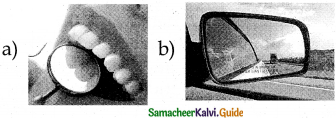
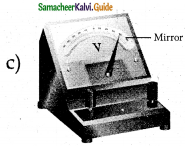
Answer:
a) Concave mirror
b) Convex mirror
c) Plane mirror
Question 15.
Define Optical path?
Answer:
Optical path of a medium is defined as the distance d’ light travels in vacuum in the same time it travels a distance d in the medium.
![]()
Question 16.
What is meant by refractive index?
Answer:
Refractive index of a transparent medium is defined as the ratio of the speed of light in vacuum (or air) to the speed of light in that medium.
Question 17.
What is meant by simultaneous reflection or refraction?
Answer:
The phenomenon in which a part of the light from a source undergoing reflection and the other part of the light from the same source undergoing refraction at the same surface is called simultaneous reflection or simultaneous refraction.
Question 18.
How do you identify a normal mirror and two-way mirror?
Answer:
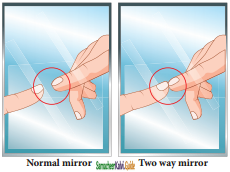
There is a method to test the two-way mirror. Place the fingernail against the mirror surface. If there is a gap between the nail and its image, then it is a regular mirror. If the fingernail directly touches its image then it is a two-way mirror.
Question 19.
Define acceptance angle in optical fiber.
Answer:
To ensure the critical angle incidence in the core-cladding boundary inside the optical fiber, the light should be incident at a certain angle at the end of an optical fiber while entering it. This is called an acceptance angle.
Question 20.
What is meant by Primary focus?
Answer:
The primary focus F1 is defined as a point where an object should be placed to give parallel emergent rays to the principal axis.
![]()
Question 21.
What is meant by secondary focus?
Answer:
The secondary focus F2 is defined as a point where all the parallel rays travelling close to the principal axis converge to form an image on the principal axis.
Question 22.
What is the reason for reddish appearance of sun during sunrise and sunset?
Answer:
- During sunrise or sunset, the light has to pass through a greater distance in the atmosphere.
- Blue light is scattered most while the red colour is less scattered and reaches the observer.
- This is the reason for reddish appearence of sun during sunrise and sunset.
Question 23.
What is meant by double refraction or birefringence?
Answer:
When a ray of unpolarised light is incident on a calcite crystal, two refracted rays are produced. Hence, two images of a single object are formed. This phenomenon is called double refraction or birefringence.
Question 24.
Give the methods of producing polarised light.
Answer:
i) Polarisation by selective absorption
ii) Polarisation by reflection
iii) Polarisation by double refraction
iv) Polarisation by scattering
Question 25.
A lens of glass is immersed in water what will be its effect on the power of the lens?
Answer:
Power of a lens, ρ α (μ – 1). As wμg < aμg so the power of glass lens will decrease when it is immersed in water.
Question 26.
What are the conditions for total internal reflection?
Answer:
i) Light must travel from denser to rarer medium.
ii) Angle of incidence in the denser medium must be greater than critical angle (i > ic).
![]()
XII. Five Marks Questions:
Question 1.
Distinguish between a wavefront and a ray of light. What are spherical, cylindrical and plane wavefronts?
Give their examples, sketch wavefront corresponding to parallel, converging and diverging rays of light?
Answer:
- The focus of All points oscillating in the same phase is called a wavefront, thus every crest or a trough is a wavefront.
- A wavefront is defined as the continuous locus of all such particles of the medium which are vibrating in the same phase at any instant.
- Thus a wavefront is a surface of constant phase. The speed with which the wavefront moves outwards from the source is called the phase speed.
- Different types of wavefront:
The geometrical shape of a wavefront depends on the source of disturbance some of the common shapes are:
i) Spherical Wavefront:
1. In the case of waves travelling in all directions from a point source, the wavefront is spherical in shape.
2. This is because all such points which are equidistant from the point source will lie on a sphere and the disturbance starting from the source S will reach all these points simultaneously.
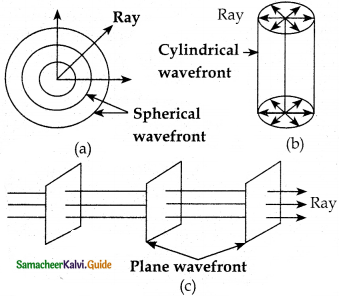
ii) Cylindrical wavefront:
1. When the source of light is linear in shape, such as a fine rectangular slit, the wavefront is cylindrical in shape.
2. This is because the locus of all such points which are equidistant from the linear source will be a cylinder.
iii) Plane wavefront:
1. As a spherical or cylindrical wavefront advances, its curvature decreases progressively.
2. So a small portion of such a wavefront at a large distance from the source will be a plane wavefront.
3. A ray of light represented the path along which light travels.
4. If we measure the separation between a pair of wavefront along any ray, it is found to be a constant
5. This illustrates two general principles:
- Rays are perpendicular to wavefronts.
- The time taken for light to travel from one wavefront to another is the same along any ray.
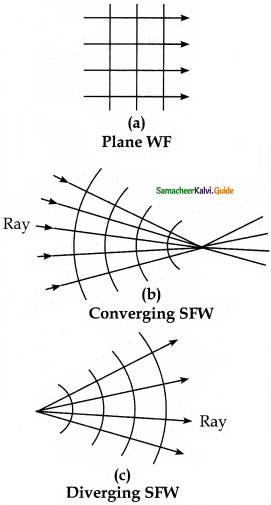
6. In case of a plane wavefront the rays are parallel
7. A group of parallel rays is called a beam of light
8. In case of a spherical wavefront the rays either converge to point or diverge from a point.
![]()
Question 2.
What are unpolarised and polarised waves? Explain polarisation, taking an example of mechanical waves. Can longitudinal waves be polarised?
Answer:
1. Polarisation of waves. The waves are of two types:
Transverse and Longitudinal. Both types of these waves undergoes reflection, refraction, interference and diffraction.
2. The difference is that only transverse waves can be polarised.
3. At transverse wave in which vibrations are present in all possible directions, in a plane perpendicular to the direction of propagation, is said to be unpolarised. If the vibrations are perpendicular to the direction of propagation, the wave is said to be polarised or plane polarised. The phenomenon of restricting the oscillations of a wave to just one direction in the transverse plane is called polarisation of waves.
Experimental demonstration:
1. Consider a long string AB passing through two rectangular slits S1 and S2
2. The end B of the string is tied to a hook in a wall and the free end A is jerked in all possible directions perpendicular to the length of the string so as to generate transverse waves in it.
3. The portion AS1 of the string has vibrations in all directions perpendicular to AB, so that the wave is unpolarised.
4. The first slit S1 will permit only those vibrations to pass through it which are parallel to the slit and will cut off all other vibrations.
5. Thus the wave emerging from the slit S1 is plane polarised. The slit S1 is called the polariser. If the second slit S2, called analyzer, is held parallel to S1, the wave from S1 will pass through S2 unchanged. If S2 is held perpendicular to S1, no vibrations will emerge from the slit S2.
6. This indicates that the slit S1 has polarised the incoming wave in the vertical plane.
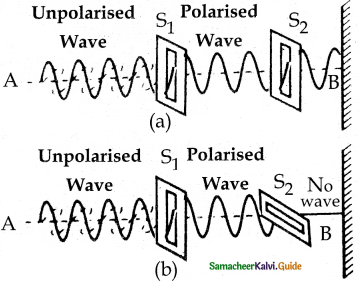
7. Longitudinal waves cannot be polarised. This is because these waves are symmetrical about the direction of propagation. For example, if we pass a long spring through two sits and generate a longitudinal wave in it by alternately compressing and releasing its free end, it is seen that the compressions and rarefactions pass through the two slits, whatever is their relative orientation.
8. This is so because the oscillations occur along the length of the spring, i.e. along the direction of the wave propagation. On the other hand, the transverse waves can be polarised as they do not show any symmetry about the direction of wave propagation.
![]()
Question 3.
What is myopia or short-sightedness? What is its cause? How can it be remedied? Explain by ray diagram
Answer:
Myopia or short-sightedness:
It is a vision defect in which a person can see nearby objects clearly but cannot see the distant objects clearly beyond a certain point. This defect is common among children.
Cause of myopia:
This defect arises due to either of the following two reasons:
i) The eyeball gets elongated along its axis so that the distance between the eye lens and the retina becomes larger.
ii) The focal length of the eye lens becomes too short due to the excessive curvature of cornea.
iii) As a result of the above causes, the parallel rays coming from a distant object do not meet at the retina but at a point in front of the retina, and the distant object is not seen clearly. The object has to be moved closer to the eye to point F to focus it on the retina. Thus the far point of a myopic eye is not at infinity but only a few metres from the eye.
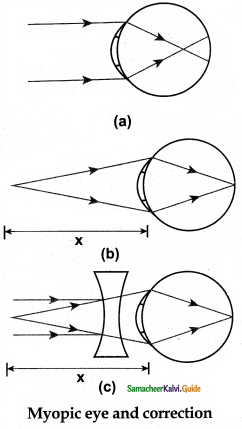
Myopic eye and correction
Correction of myopia:
1. A myopia eye is corrected by using a concave lens of focal length equal to the distance of the far point F from the eye.
2. This lens diverges the parallel rays from distant object as if they are coming from the far point F. Finally, the eye lens forms a clear image at the retina.
Question 4.
How can we determine the focal length and power of the concave lens required to correct a myopic eye?
Answer:
Calculation of focal length and power of correcting lens in myopia:
Let x be the distance of the actual far point from the eye and hence from the concave lens placed close to the eye. The rays coming from infinity, after refraction through the concave lens, appear to come from the far point F.
∴ u = -∞, υ = -x, f = ?
By lens formula,
\(\frac{1}{f}=\frac{1}{v}-\frac{1}{u}=\frac{1}{-x}-\frac{1}{-\infty}={-\frac{1}{x}+0=-\frac{1}{x}}\)
∴ Required focal length, f = -x
Required power, P = \(\frac{1}{f}=-\frac{1}{x}\)
The negative sign shows that the correcting lens is a concave lens.
![]()
Question 5.
What is hypermetropia or long¬sightedness? What is its cause? How can it be corrected? Explain by ray diagrams.
Answer:
Hypermetropia or long-sightedness:
It is a vision defect in which a person can see distant objects clearly but cannot see the nearby objects clearly.
Cause of Hypermetropia:
This defect arises due to either of the following reasons:
i) The eyeball becomes too small along its axis so that the distance between the eyelens and the retina is reduced.
ii) The focal length of the eye lens becomes too large resulting in the low converging power of the eyelens.
As a result of the above causes, the rays coming from an object placed at 25 cm (normal near point) from the eye meet at point behind the retina. So the object is not seen clearly.
To focus the rays again on the retina, the object has to be moved away from the eyes to a distance greater than 25 cm, Thus the near point of the eye is not at 25 cm but it has shifted to N’ at a distance greater than 25 cm from the eyes.
Correction of hypermetropia:
A hypermetropia eye is corrected by using a convex lens of suitable focal length.

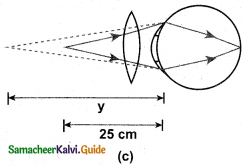
Hypermetropic eye and correction
This lens converges the rays such that the rays coming from normal near point N appear to come after refraction, from near point N’ of the defected eye. That is a virtual image of the object placed at N is formed at N’. Then the eyelens forms a clear image at the retina.
Question 6.
What is presbyobia? How does it differ from hypermetropia?
Answer:
Presbyopia:
- This defect is similar to hypermetropia i.e. a person having this defect cannot see nearby objects distinctly, but can see distant objects without any difficulty.
- This defect differs from hypermetropia in the cause by which it is produced. It usually occurs in elderly persons.
- Due to the stiffening of the ciliary muscles, § the eyelens loses flexibility and hence the accommodating power of the eyelens deceases.
- Like hypermetropia, this defect can be corrected by using a convex lens of suitable focal length.
![]()
Question 7.
What is astigmatism? How is it caused? How is it corrected?
Answer:
Astigmatism:
It is the defect of vision in which a person cannot simultaneously see both the horizontal and vertical views of an object with the same clarity. This defect can occur along with myopia or hypermetropia.
Cause of astigmatism:
1. This defect occurs when the cornea is not perfectly spherical in shape. It may have a large curvature in the vertical plane than in the horizontal plane or vice versa.
2. If one looks at a wire mesh with such a defect in the evelens, focusing in the vertical plane may not be as sharp as in the horizontal plane or vice versa.
3. Astigmatism results in lines in one direction well focused while those in perpendicular direction will be distorted or curved.
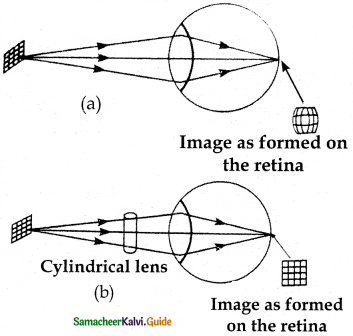
Correction of Astigmatism:
Astigmatism can be corrected by a lens whose one surface is cylindrical. Such a surface focuses rays in one plane but not in the perpendicular plane. By suitably choosing the radius of curvature and axis direction of the cylindrical surface astigmatism can be corrected.
Question 8.
How can we determine the focal length and power of the convex lens required to correct a hypermetropic eye?
Answer:
Calculation of focal length and power of correcting lens in hypermetropia.
Let y = distance of the near point N’ from the defective eye. Now the near point N of the normal eye is at distance D = 25 cm. The object placed at N forms its virtual image at N’ due to the convex lens.
∴ u = -D, ν = -y,f = ?
By lens formula
\(\frac{1}{f}=\frac{1}{v}-\frac{1}{u}=\frac{1}{-y}-\frac{1}{-D}=\frac{y-D}{y D}\)
∴ Required focal length
f = \(\frac{y D}{y-D}\)
Required power P = \(\frac{1}{f}=\frac{y-D}{y D}\)
As y > D, so both f and D are positive. That is the correcting lens must be a convex lens.
![]()
XIII. Additional Problems:
Question 1.
White light is incident on a small angled prism of angle 5° calculate the angular dispersion if the refractive indices of red and violet rays are 1.642 and 1.656 respectively.
Answer:
Angular dispersion δv – δr = (μv – μr) A
= (1.656 – 1.642) 5°
= 0.070°
Angular dispersion = 0.070
Question 2.
A person runs towards a plane mirror at a speed of 1.5ms-1. with what speed does the image approach the person?
Answer:
The person moves towards the mirror by 1.5 m in one second. Hence the image moves towards the mirror by 1.5 m in one second.
∴ The net displacement of the image with respect to the person is = 1.5 + 1.5 = 3m per second
Question 3.
Calculate the Refractive index of the material. Whose polarising angle is 60°.
Answer:
ip = 60°
tan ip = n
n = tan ip
= tan 60°
n = 1.732
Question 4.
Young’s double slit experiment two coherent sources of intensity ratio of 64 : 1, produce interference fringes. Calculate the ratio of maximum aqd minimum intensities.
Answer:
Given data:
I1 : I2 : : 64 : 1
\(\frac{I_{\max }}{I_{\min }}\) = ?
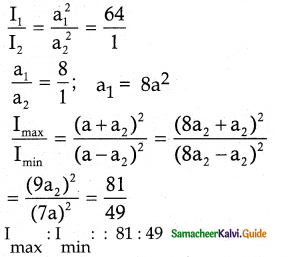
Question 5.
A parallel beam of monochromatic light is allowed to incident normally on a plane transmission grating having 5000 lines per centimetre. A second order special line is found to be diffracted at an angle 30° Find the wavelength of the light?
Answer:
Data:
N=5000 lines/cm = 5000 × 102 lines/m
m = 2; θ = 30°; λ = ?
sin θ = Nm λ
λ = \(\frac{\sin \theta}{\mathrm{Nm}}\)
λ = \(\frac{\sin 30^{\circ}}{5 \times 10^{5} \times 2}=\frac{0.5}{5 \times 10^{5} \times 2}\)
λ = 5 × 10-7 m = 5000 Å
![]()
XIV. Additional problems:
Question 1.
The light of wavelength 590 nm, 596nm are used in turn to study the diffraction taking place a single slit of aperture 2 × 10-1 in. The distance between the slit and the screen is 1.5m. Calculate the separation between the positions of first maximum of the diffraction pattern obtained in the two cases.
Answer:
Wave length of first sodium line,
λ1 = 590 nm
Wavelength of second sodium line,
λ2 = 596 nm
Aperture or width of single slit, d = 2 × 10-4 m
Distance between the slit and the screen, D = 1.5 m
Separation between the first maximum is given by,
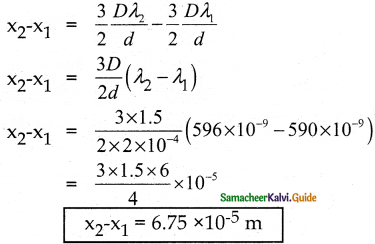
Question 2.
A monochromatic light of wavelength 589 nm is incident on a water surface having refractive index 1.33. Find the velocity, frequency and wave length of light in water, μ (refractive index of water)
Answer:
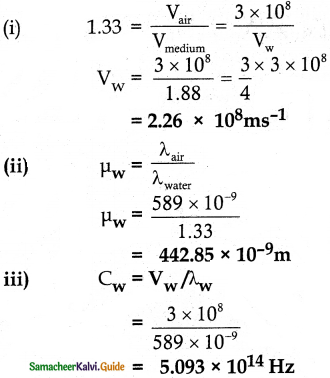
![]()
Question 3.
A transmission grating has 5000 lines/cm. Calculate the angular separation in second order spectrum of red line 7070 Å and blue line 5000 Å.
Answer:
(i) sin θ = Nmλ
sin θR = 5 × 105 × 2 × 7070 × 10-10
sin θR = 1/√2
θR = 45°
(ii) sin θB = 5 × 105 × 2 × 5 × 10-7
= 50 × 10-2 = 0.5
θB = 30°
Angular separation (θR – θB) = 45° – 30° = 15°
Question 4.
An object is placed at a distance of 20.0 cm from a concave mirror of focal length 15.00 m. What distance from the mirror a screens should be placed to get a sharp image? What is the nature of image? F=-150m, u = -20 cm
Answer:
F = 150 m, u = -20 cm
a) 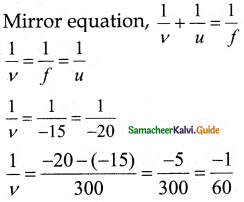
ν = – 60 cm
The screen is to be placed at distance 60 cm to the left of the concave mirror.
b) Magnification, m = \(\frac{h^{\prime}}{h}=\frac{-v}{u}\)
m = \(\frac{h^{\prime}}{h}=\frac{-v}{u}\) = -3
As magnification is negative, the image is inverted.
Question 5.
The refractive index of a prism material is 1.541. Find its critical angle.
Answer:
Given data:
n = 1.541
ic = sin-1 \(\left(\frac{1}{n}\right)\)
= sin-1 \(\left(\frac{1}{1.541}\right)\)
ic = sin-1 (0.6489)
ic = 40°5′
Question 6.
A microscope has an objective and eyepiece of focal lengths 5 cm and 50 cm respectively with tube length 30 cm. Find the magnification of the microscope in the near point and normal focusing.
Answer:
f0 = 5cm = 5 × 10-2 m;
fe = 50 cm = 50 × 10-2 m;
L = 30cm =30 × 10-2 m;
D=25 cm = 25 × 10-2 m
(i) The total magnification m in near point focusing is,
m = m0 me = \(\left(\frac{L}{f_{0}}\right)\left(1+\frac{D}{f_{0}}\right)\)
Substituting,
m = m0 me = \(\left(\frac{30 \times 10^{-2}}{5 \times 10^{-3}}\right)\left(1+\frac{25 \times 10^{-2}}{50 \times 10^{-2}}\right)\)
= (6) (1.5) = 9
(ii) The total magnification m in normal focusing is,
m = m0 me = \(\left(\frac{L}{f_{0}}\right)\left(\frac{D}{f_{e}}\right)\)
Substituting,
m = m0 me
= \(\left(\frac{30 \times 10^{-2}}{5 \times 10^{-3}}\right)\left(\frac{25 \times 10^{-2}}{50 \times 10^{-2}}\right)\)
= (6) (0.5)
= 3